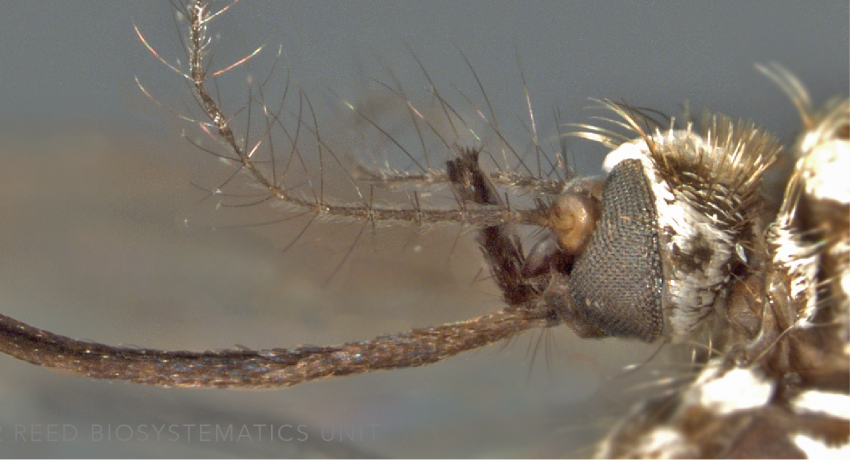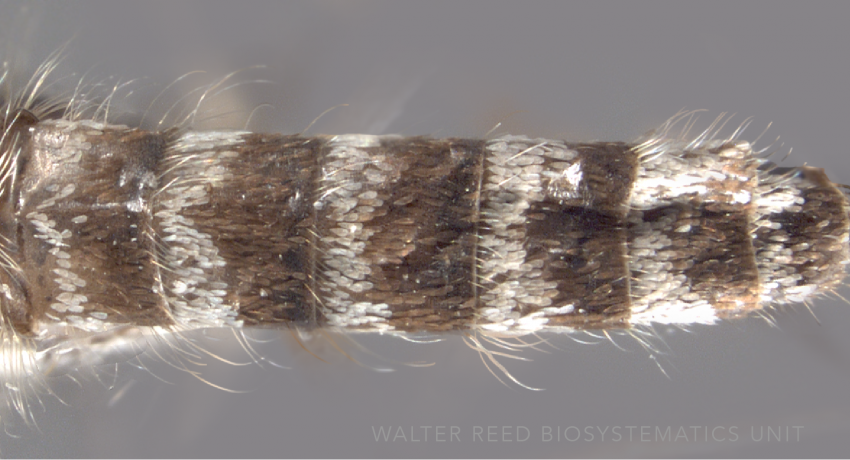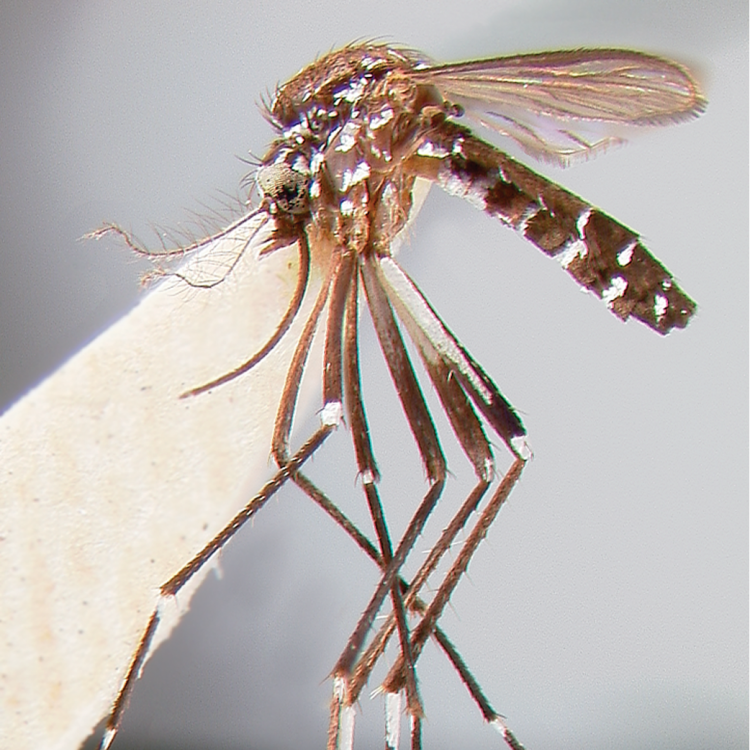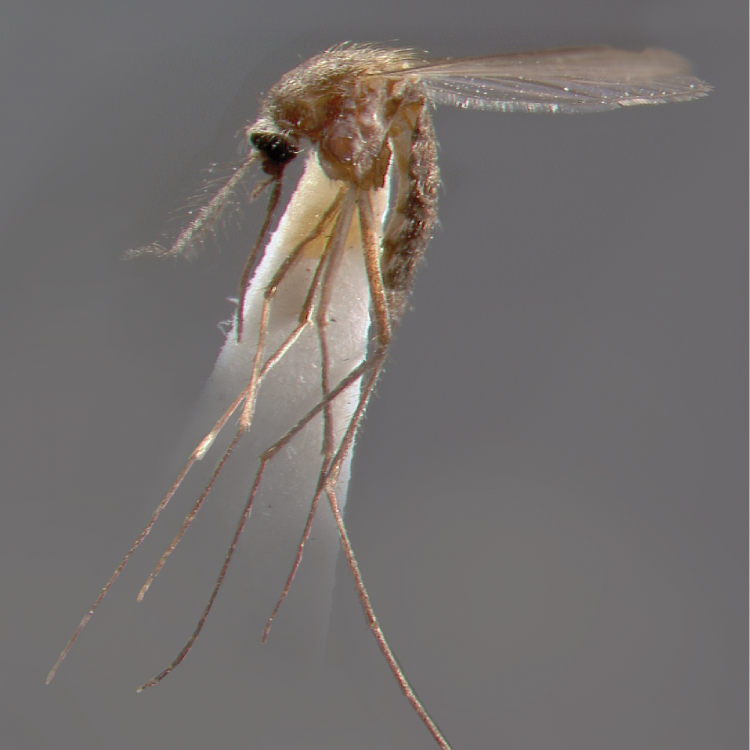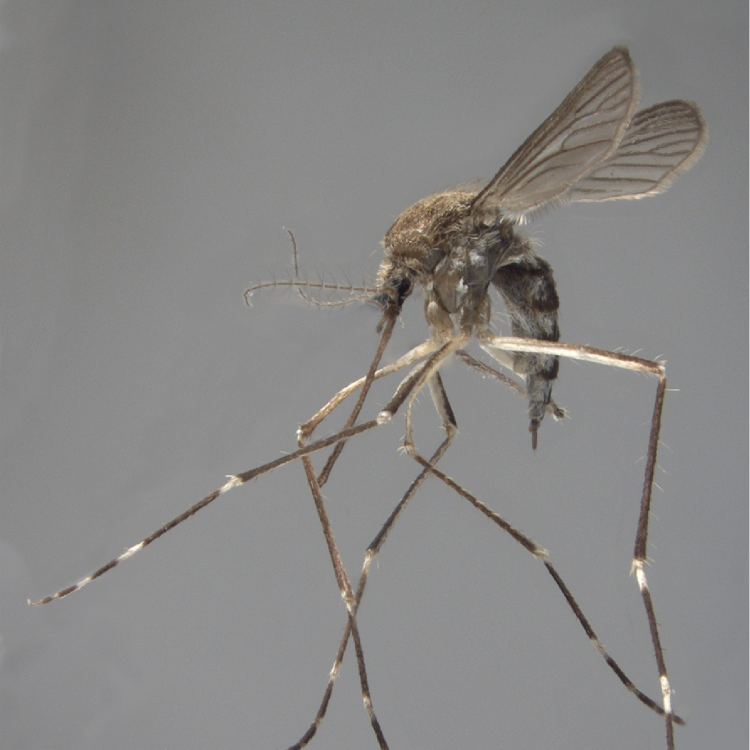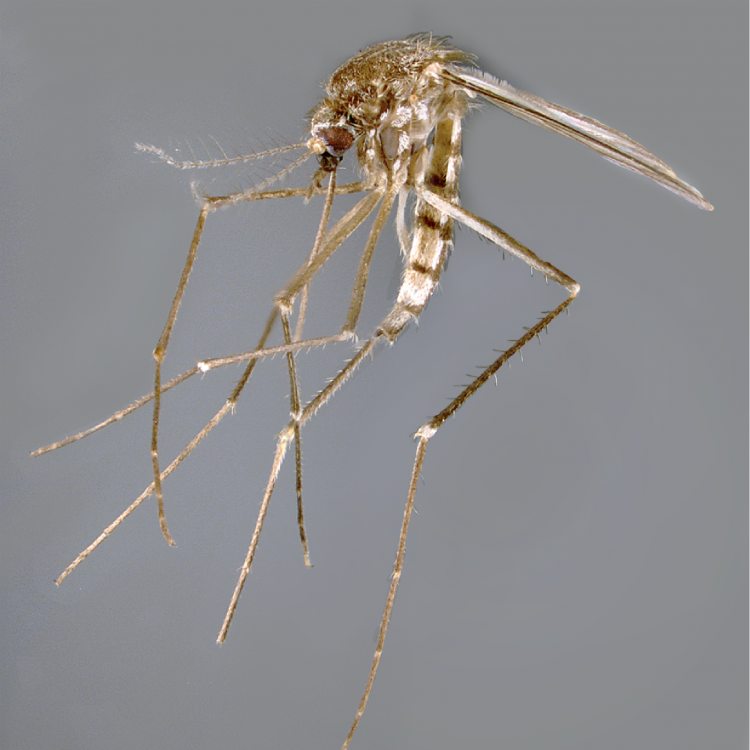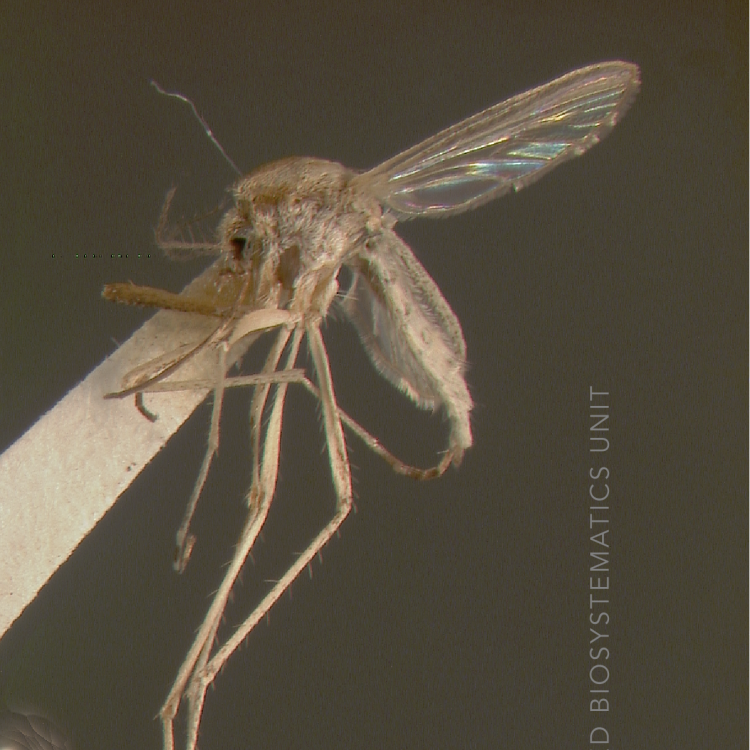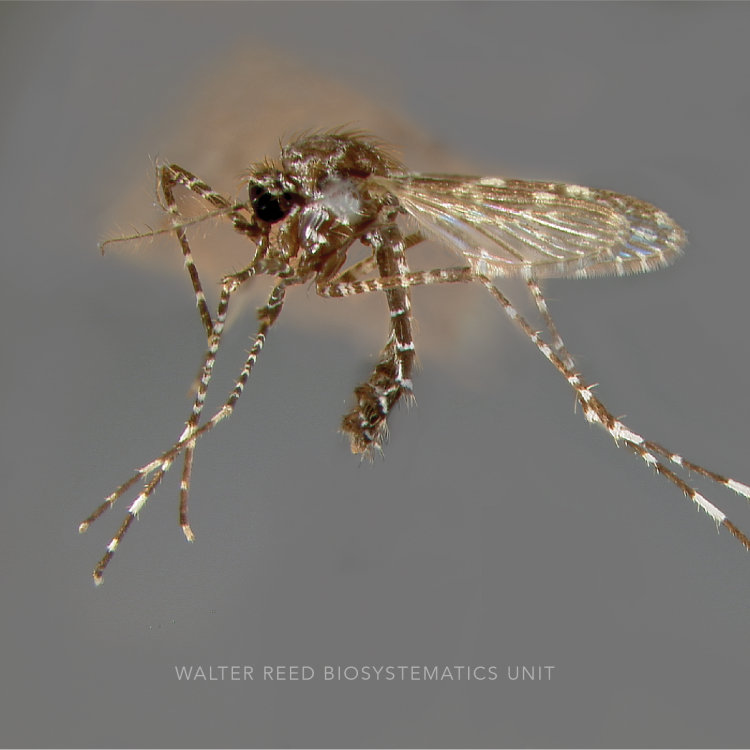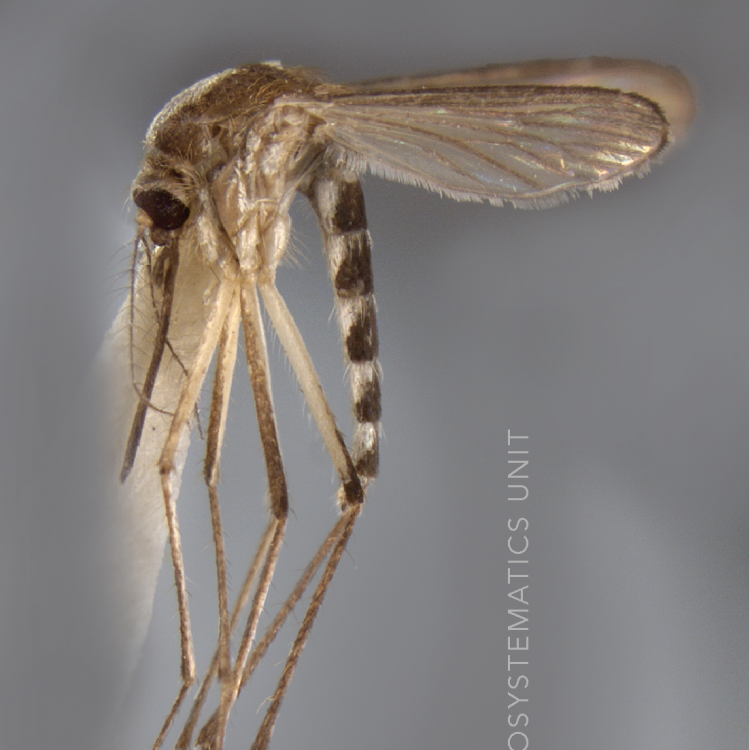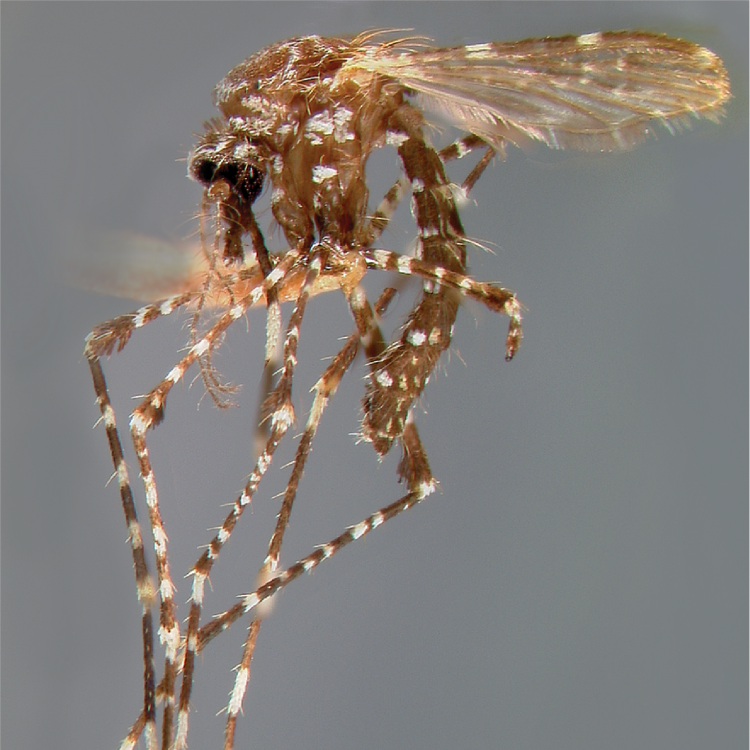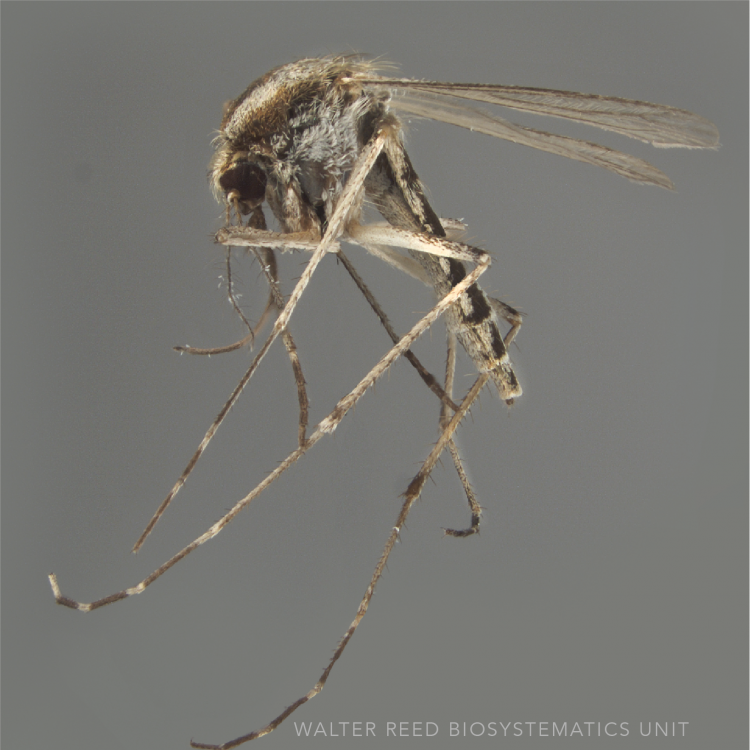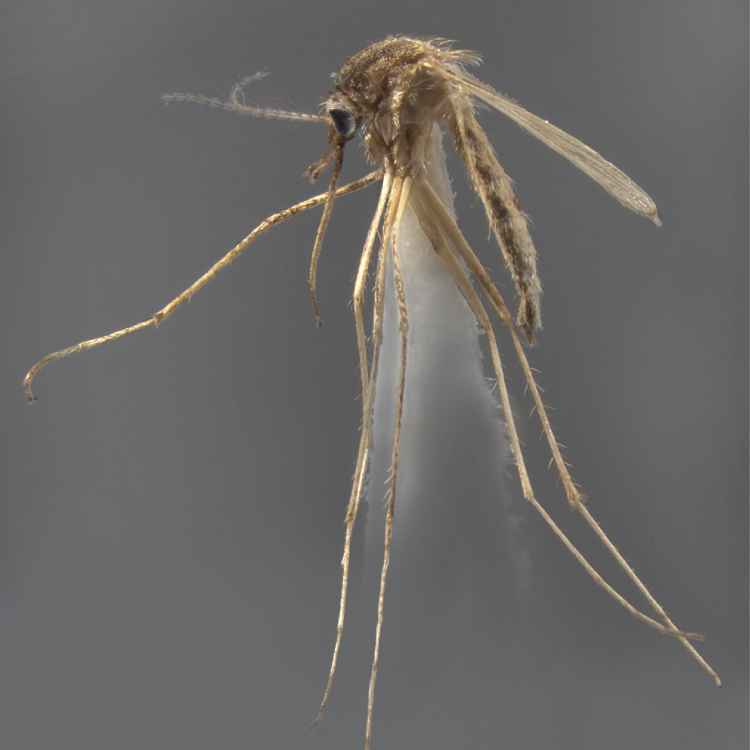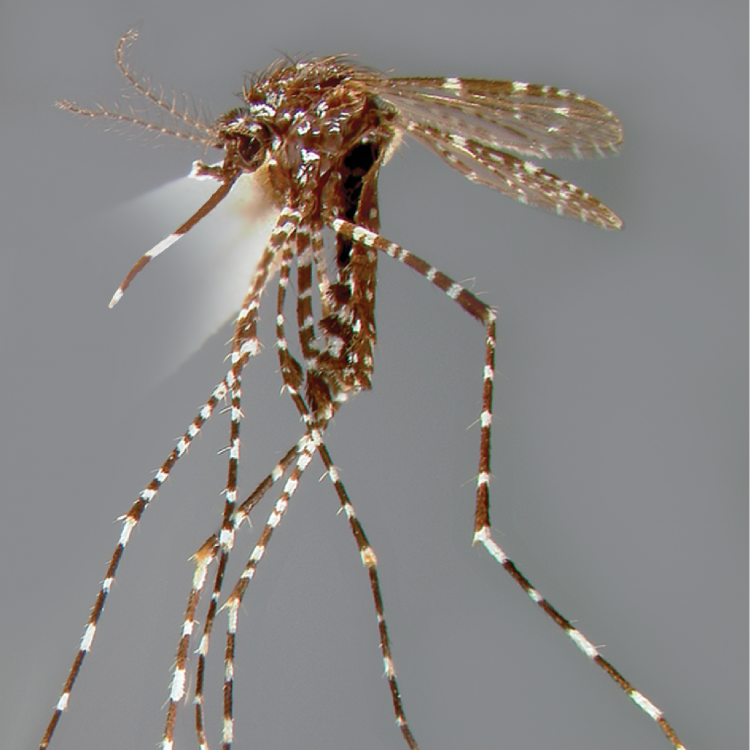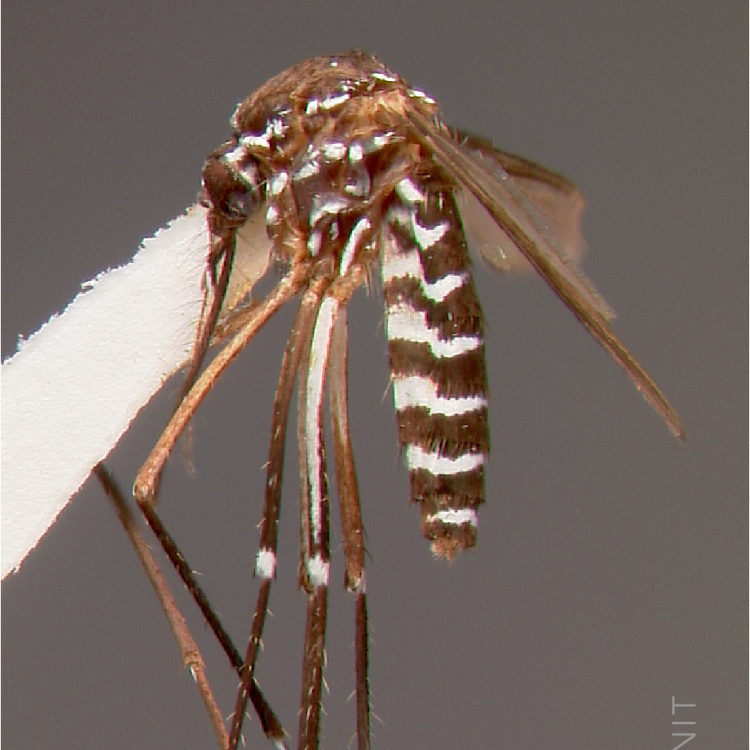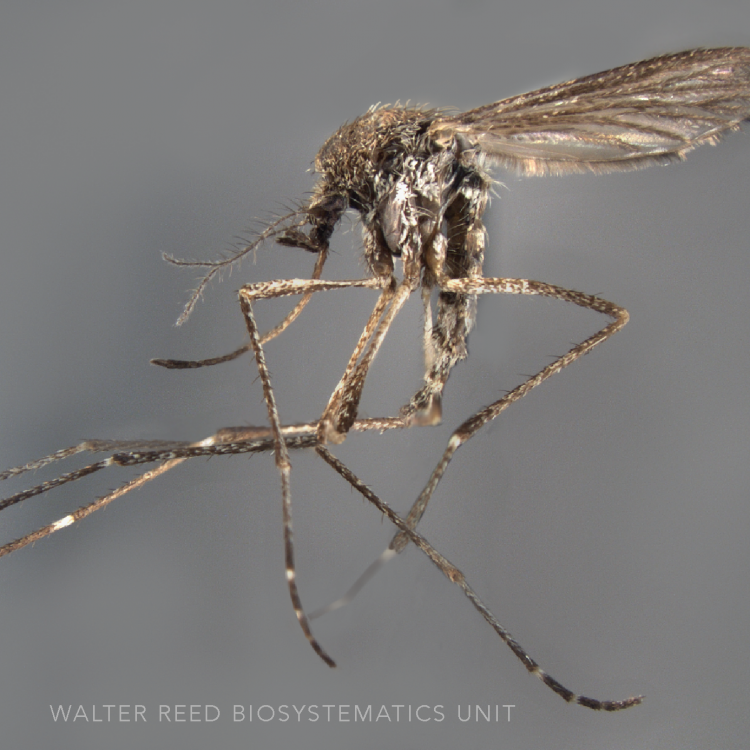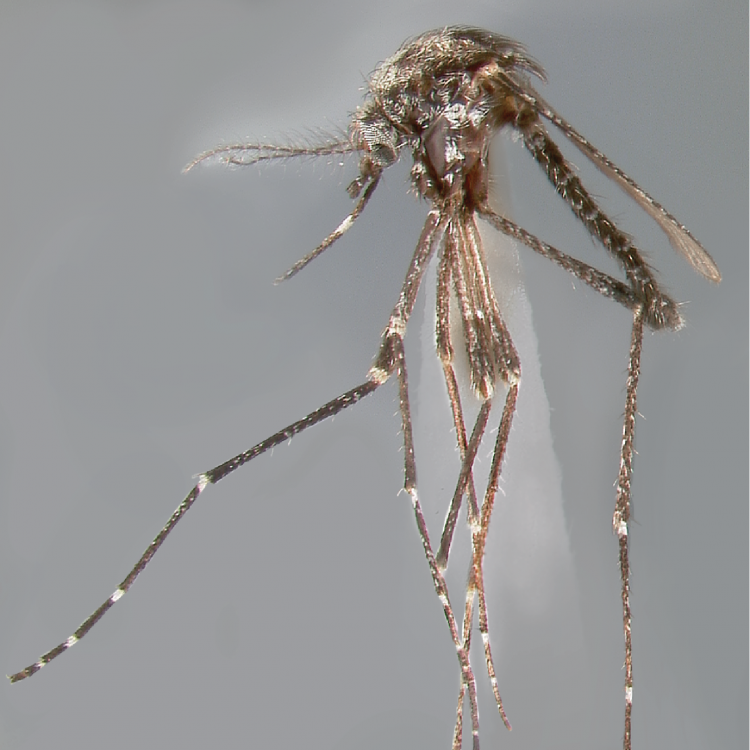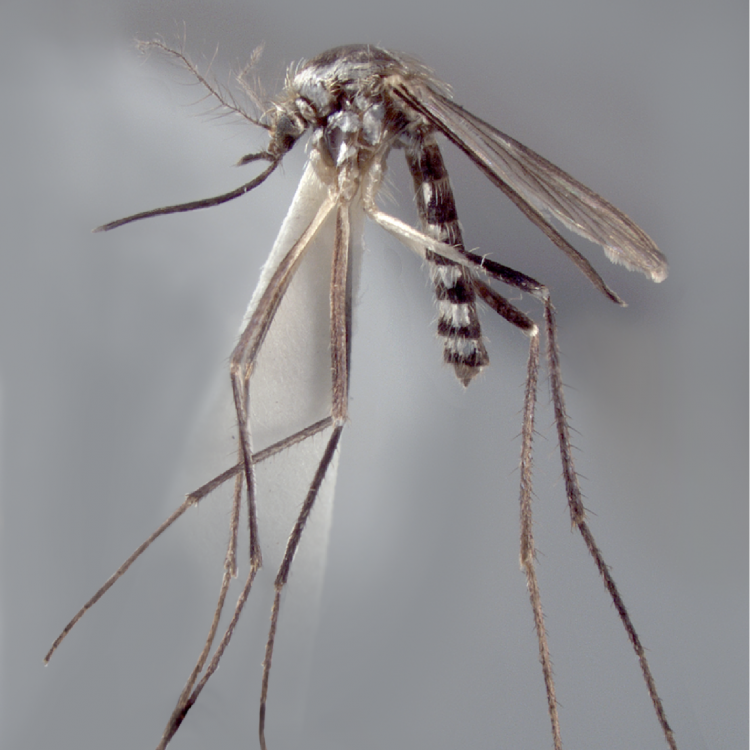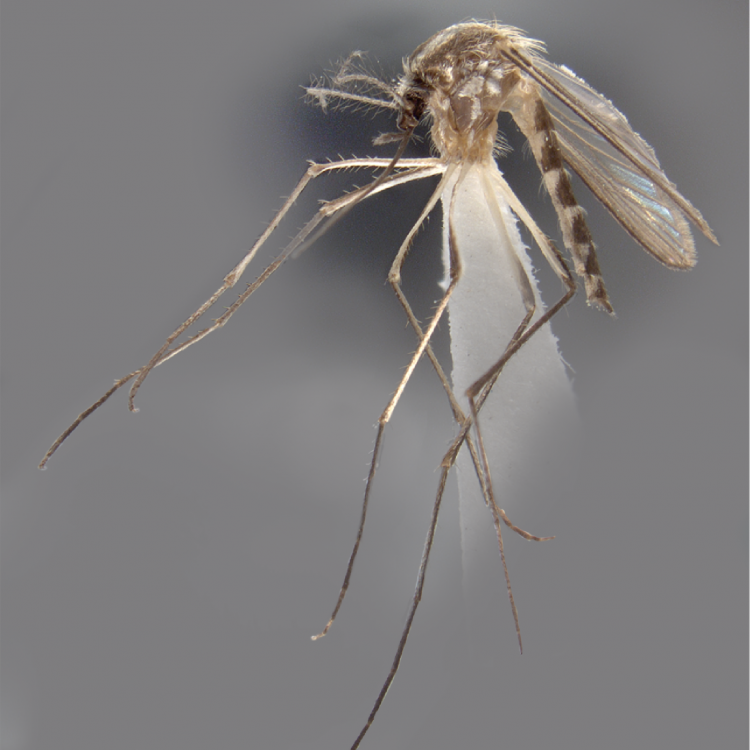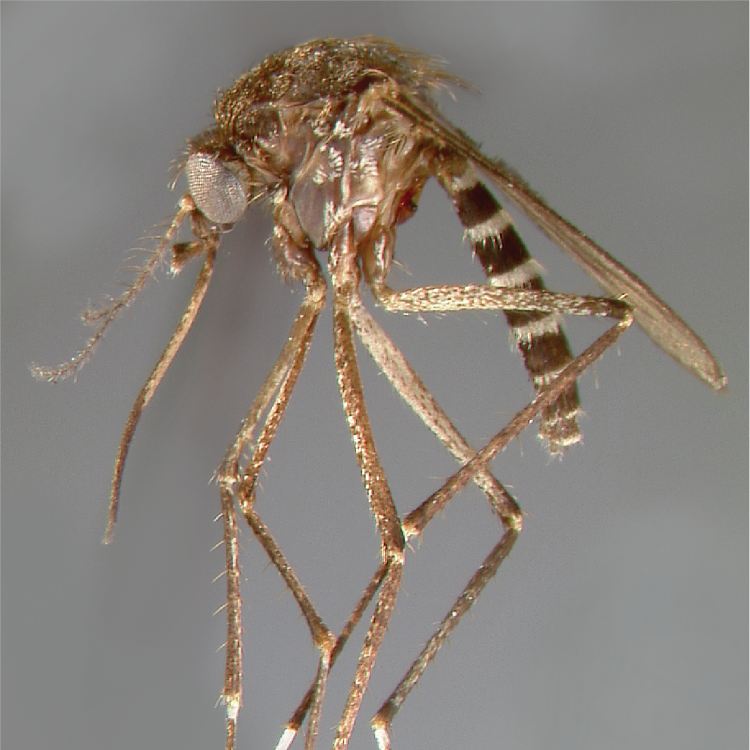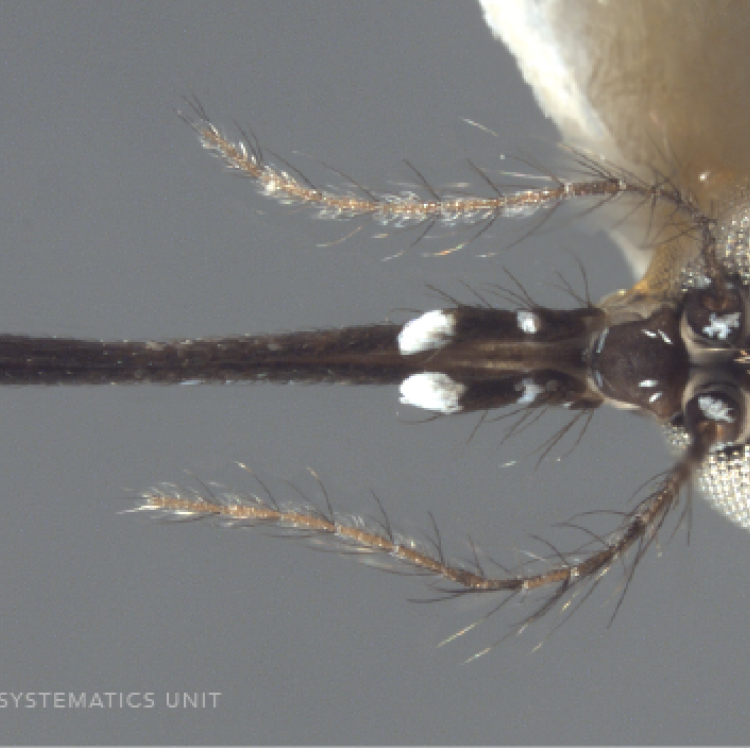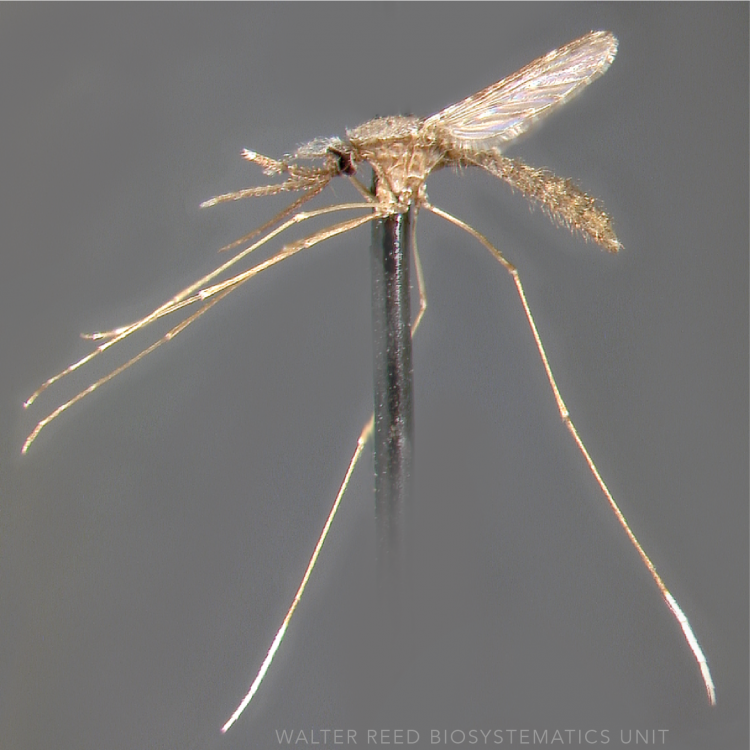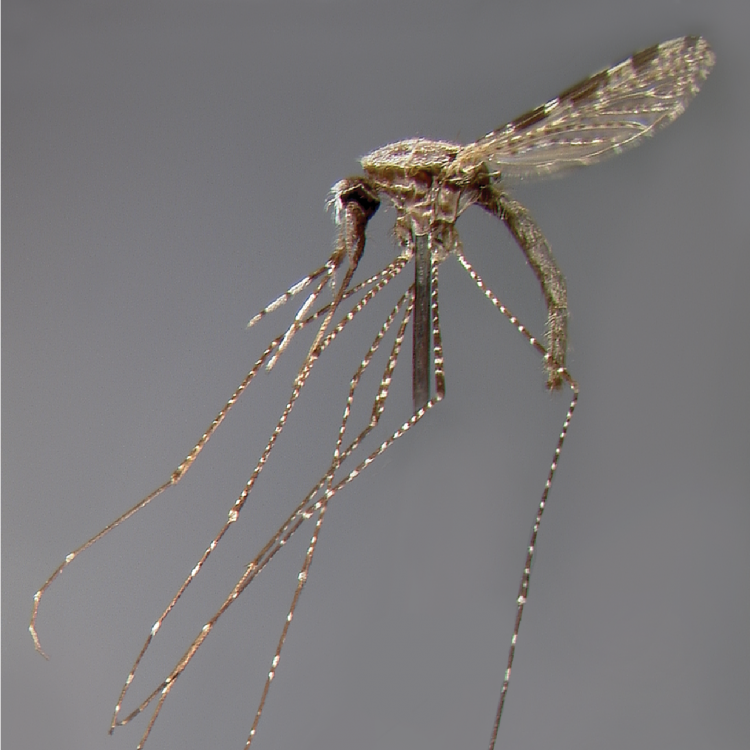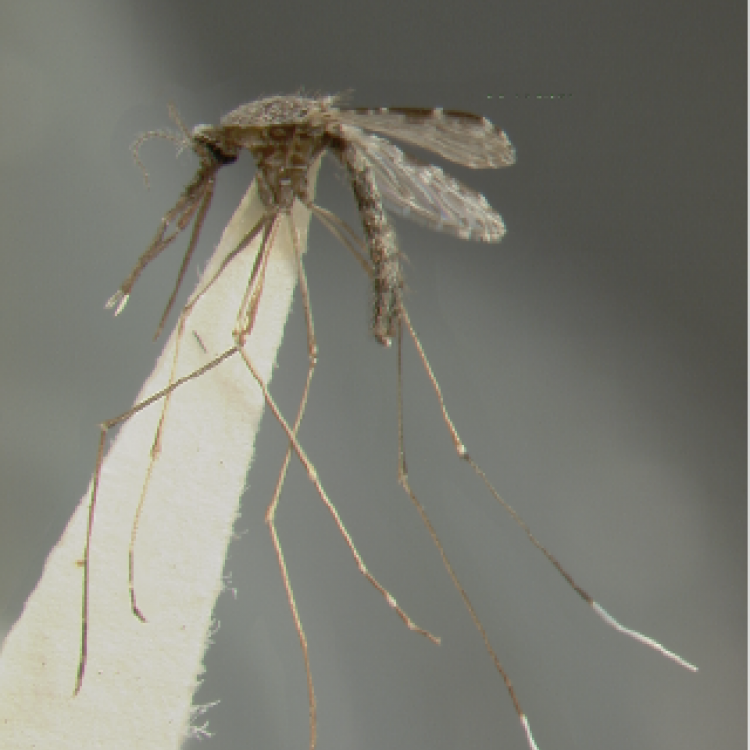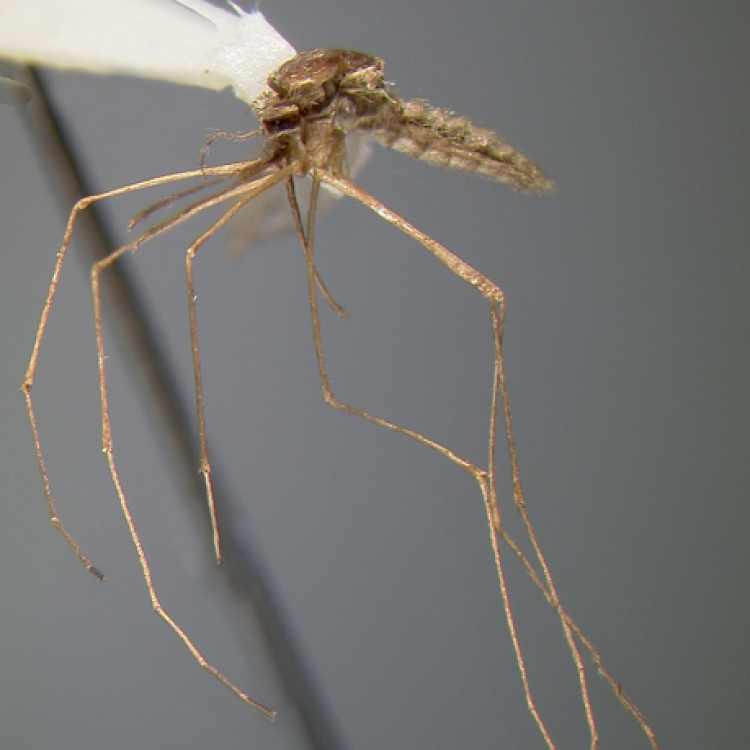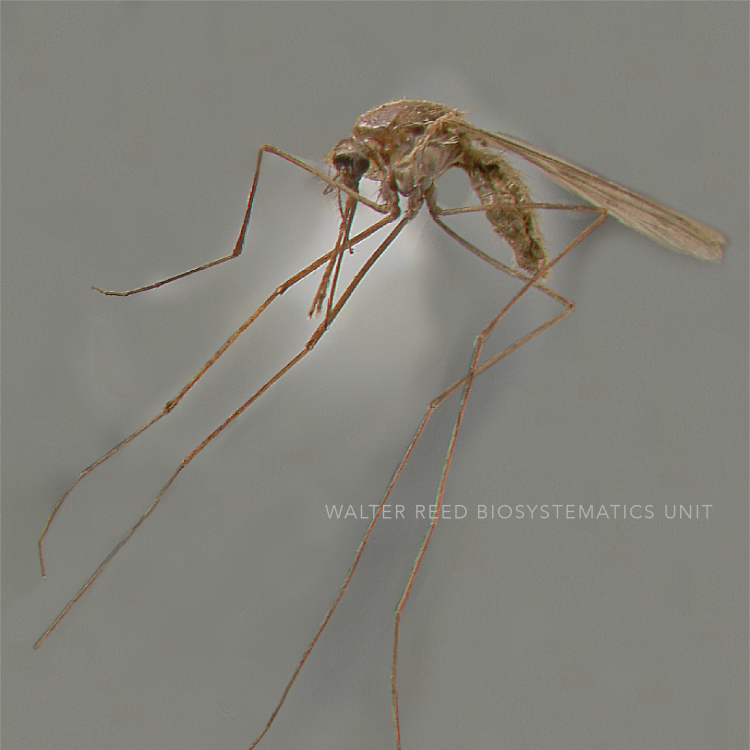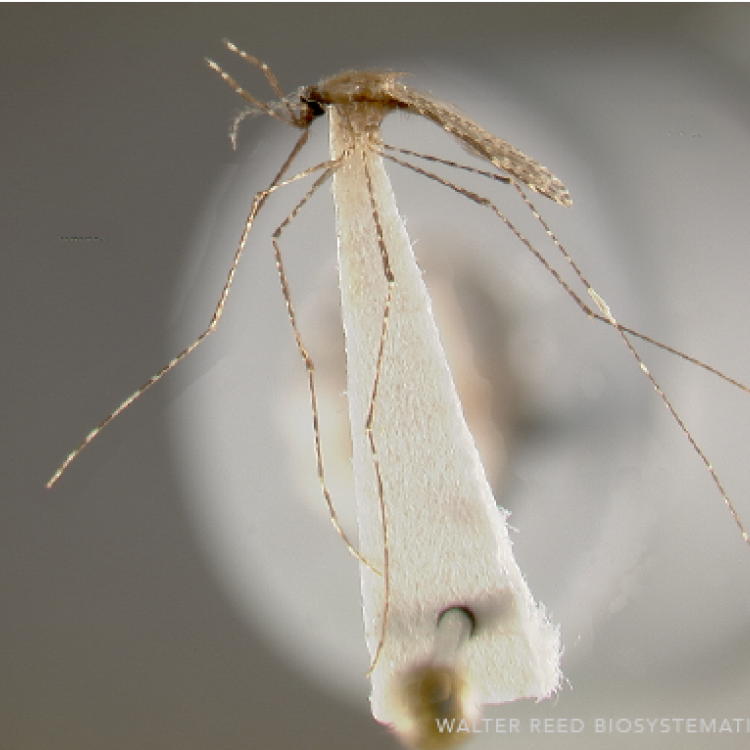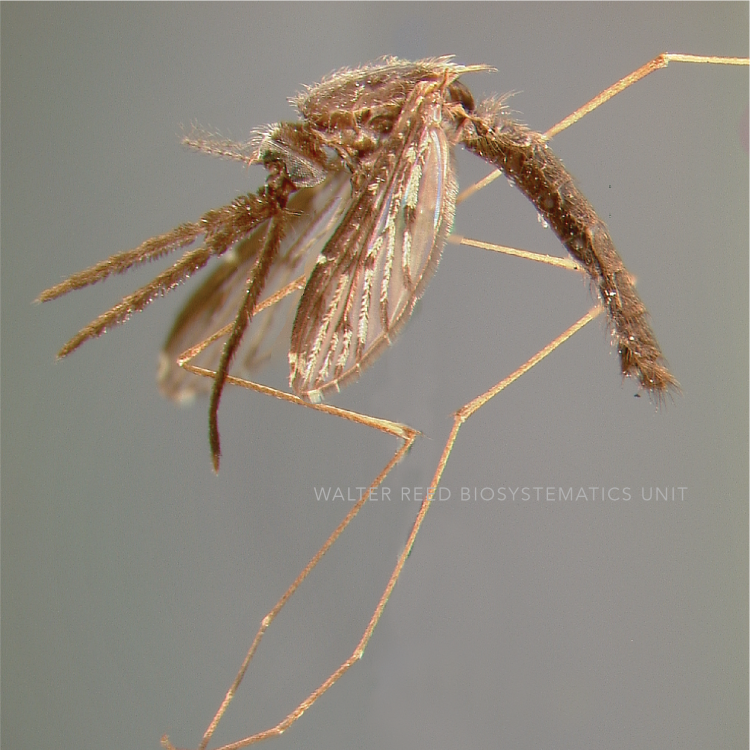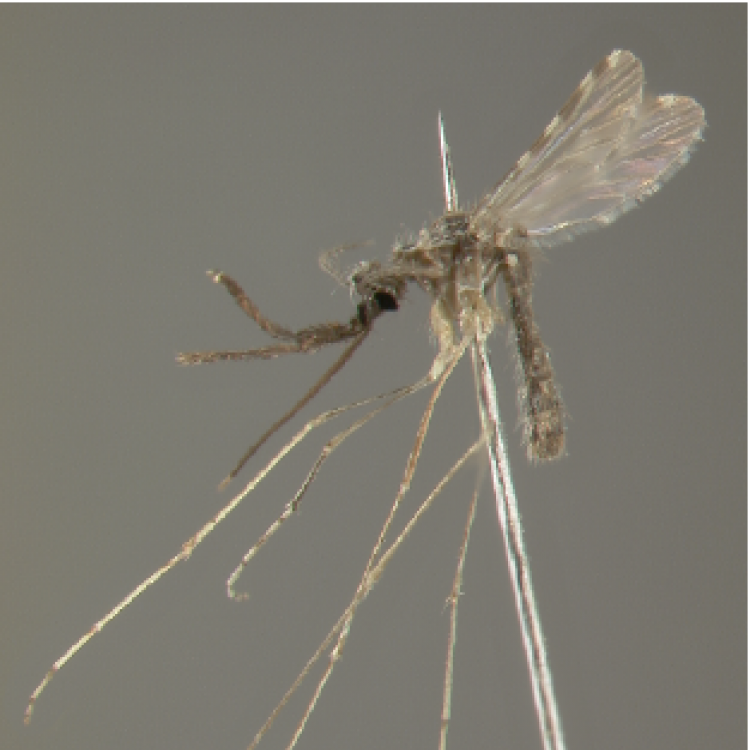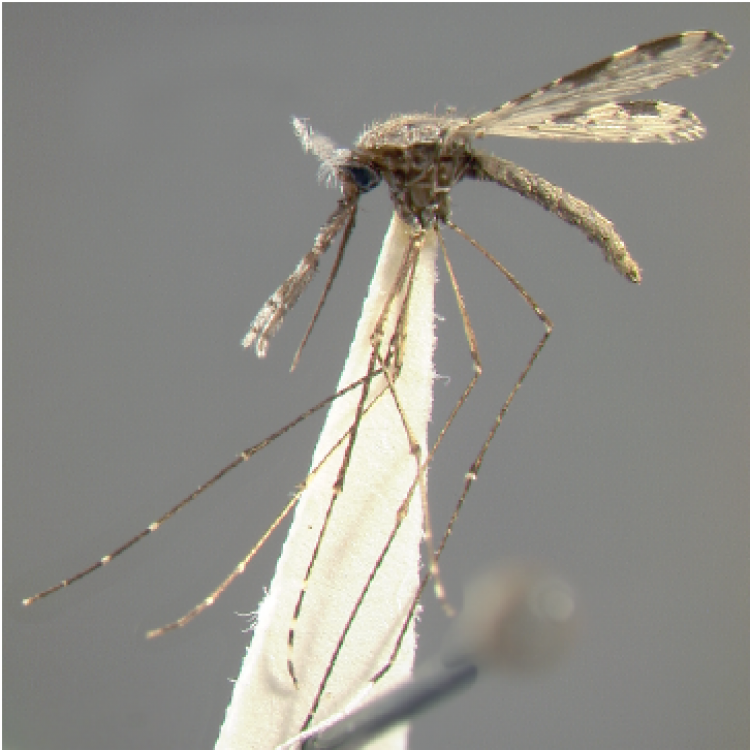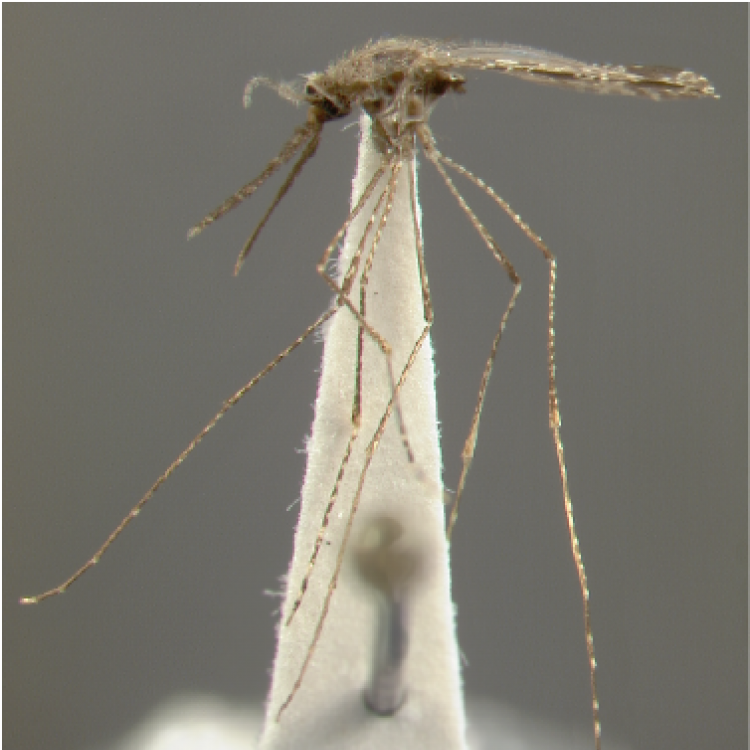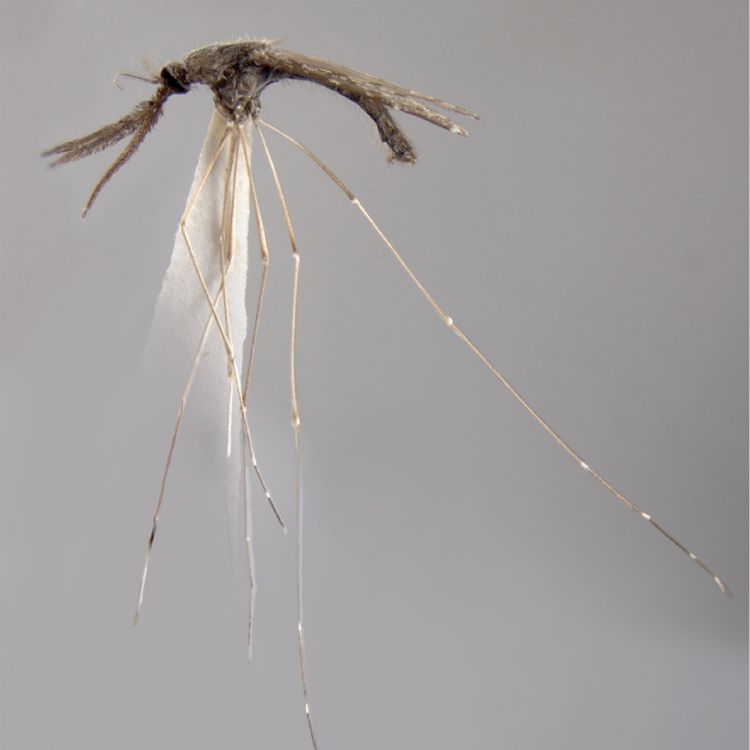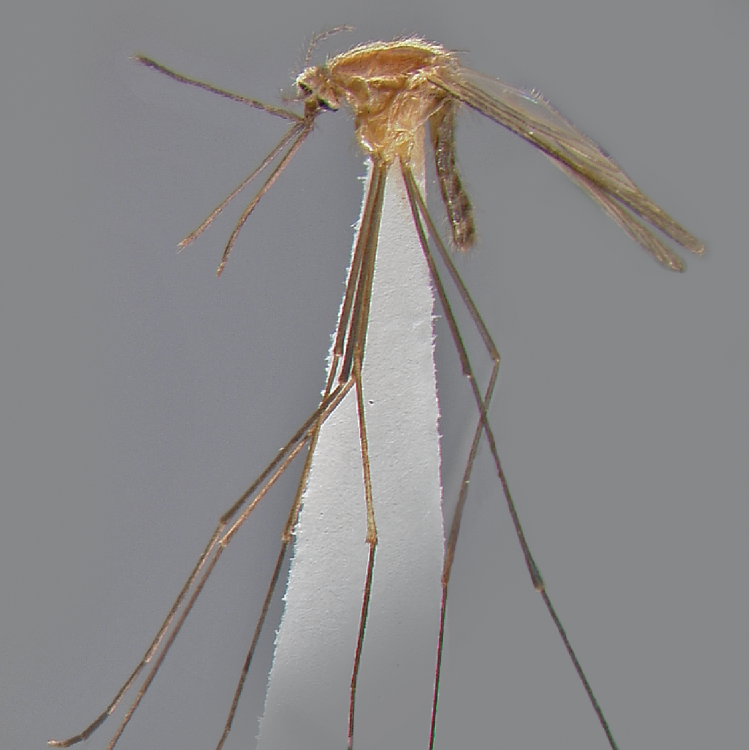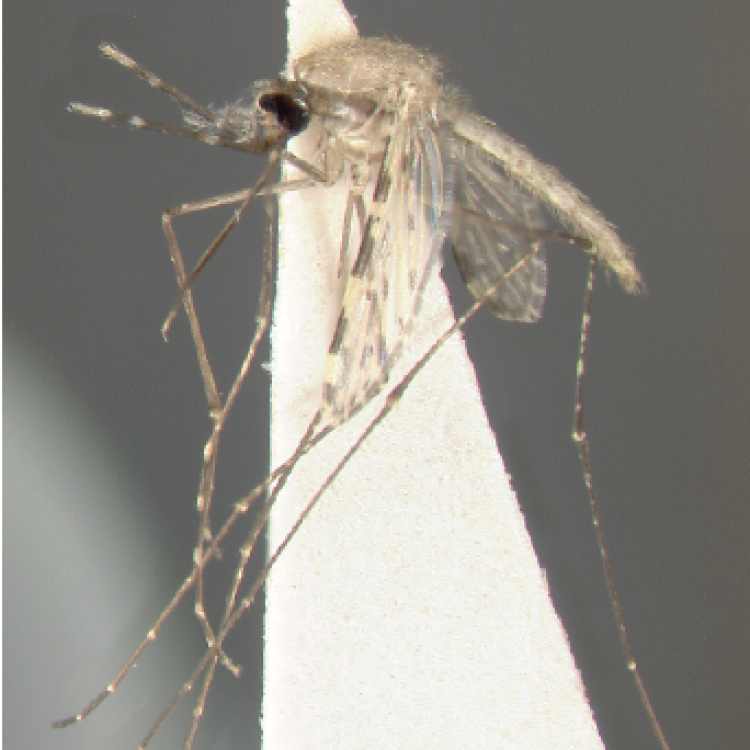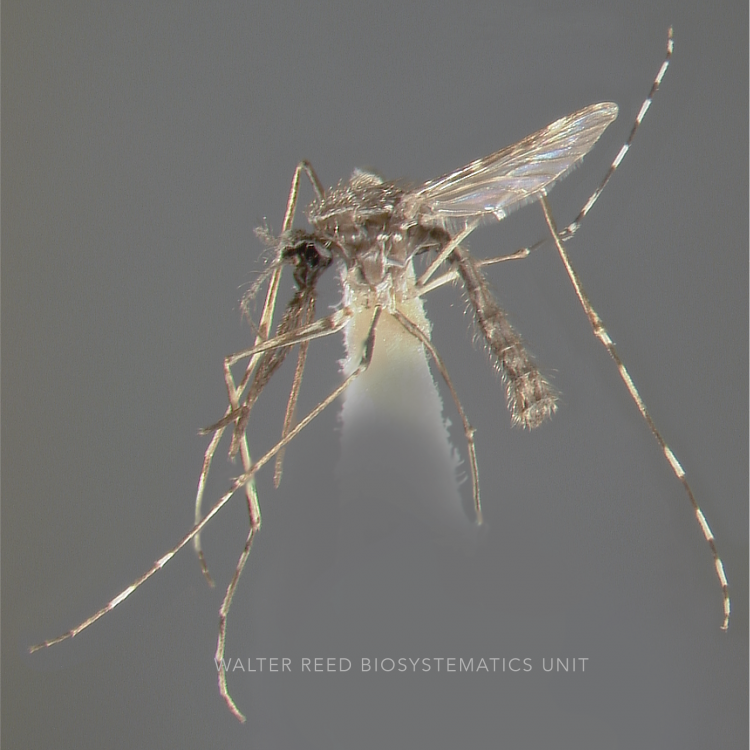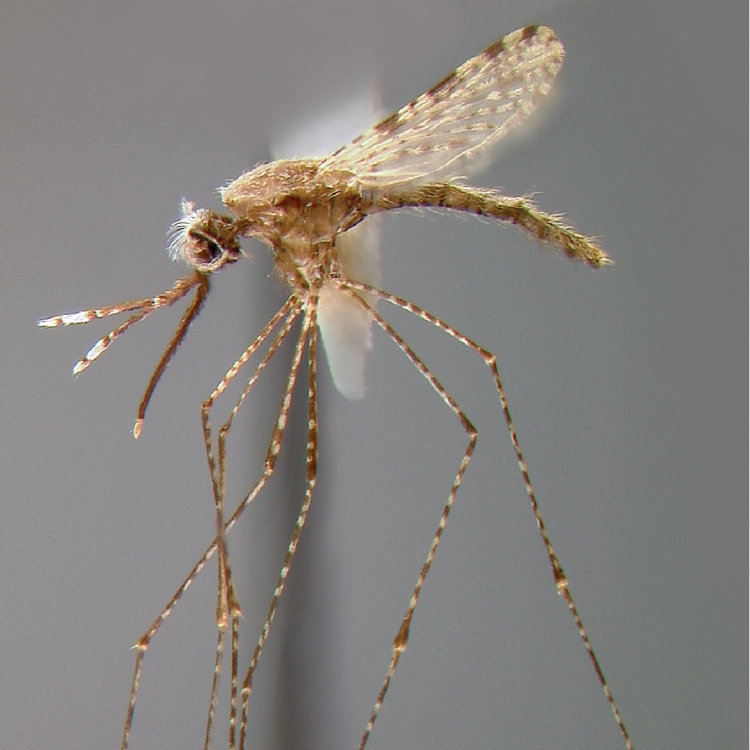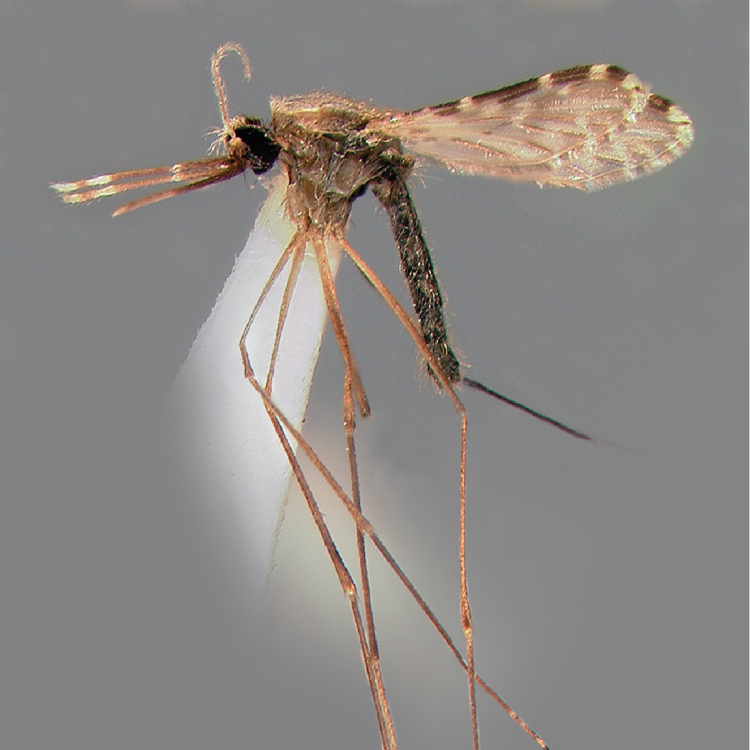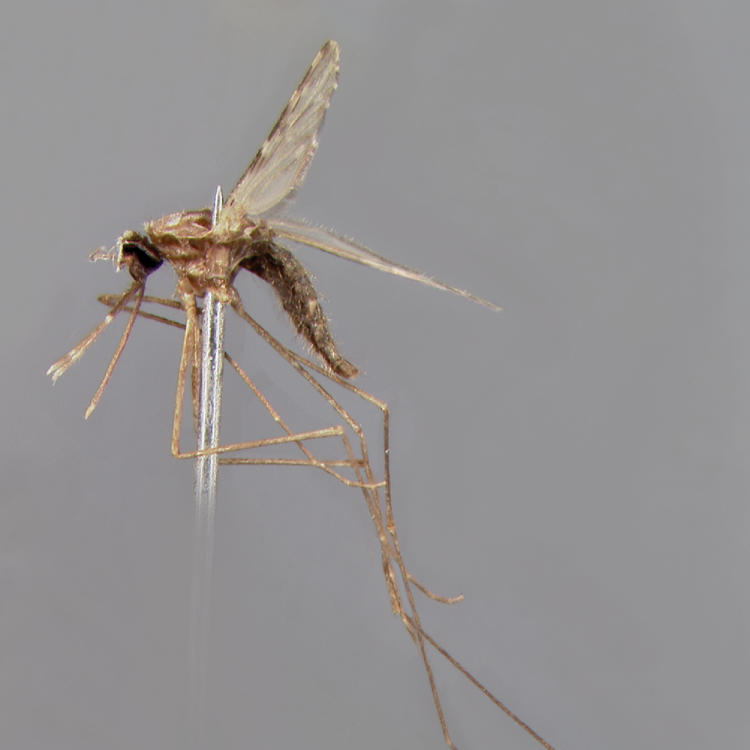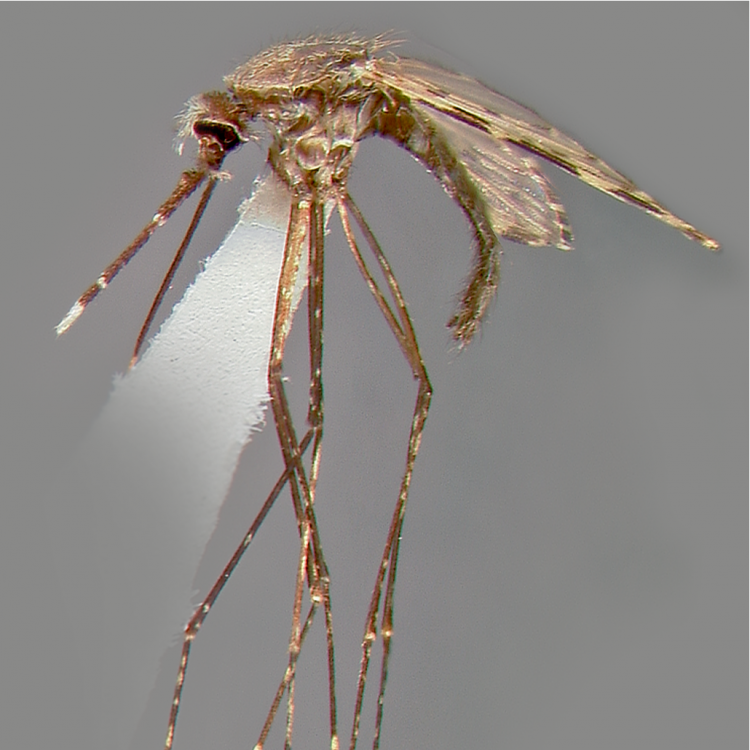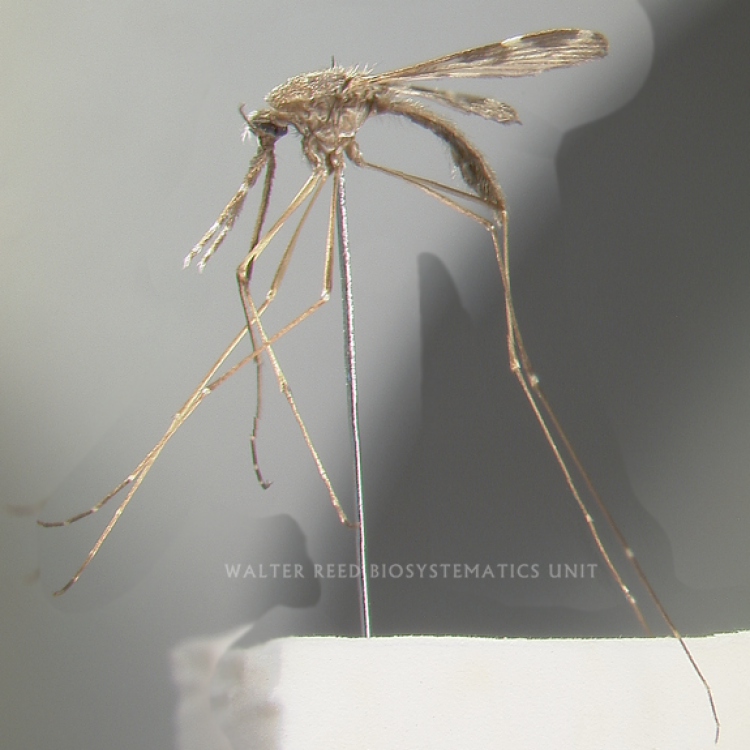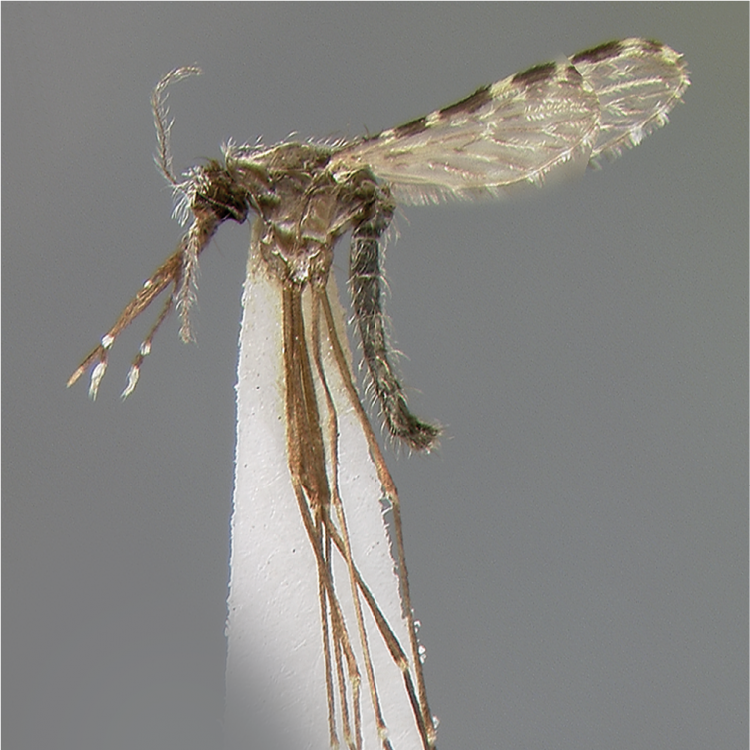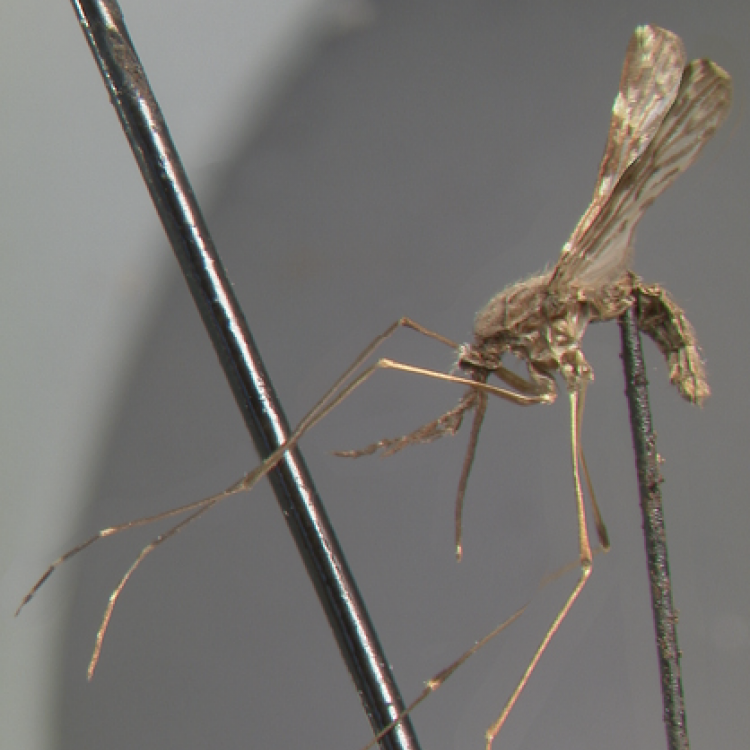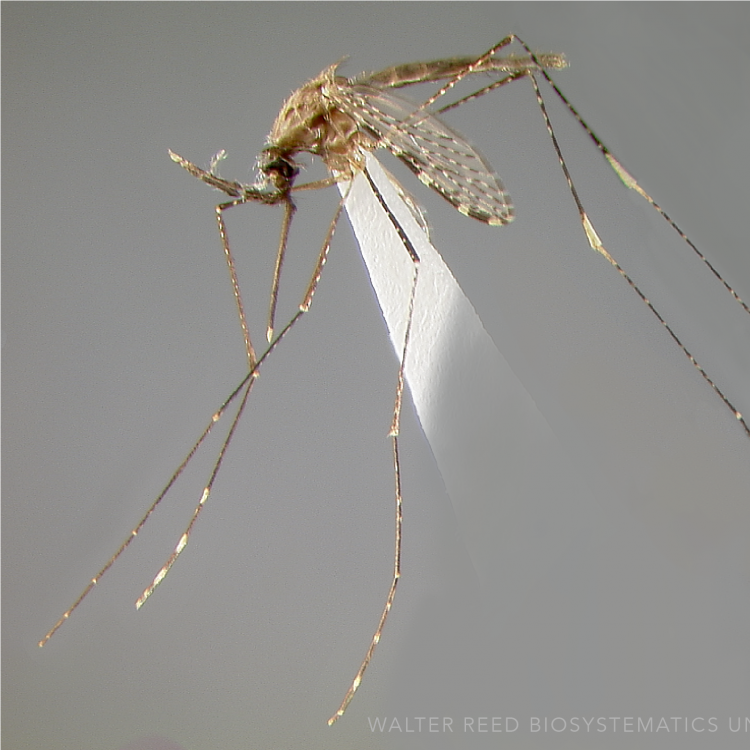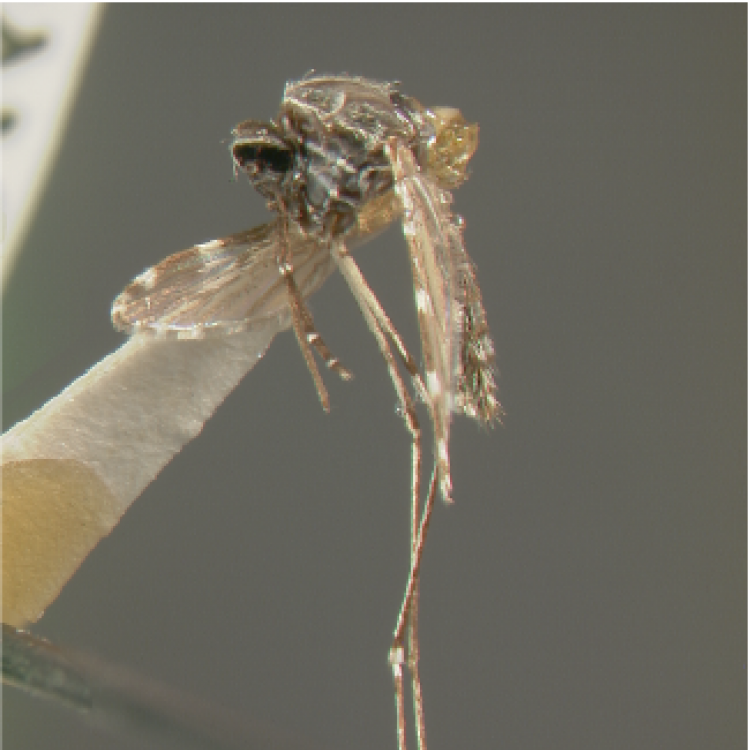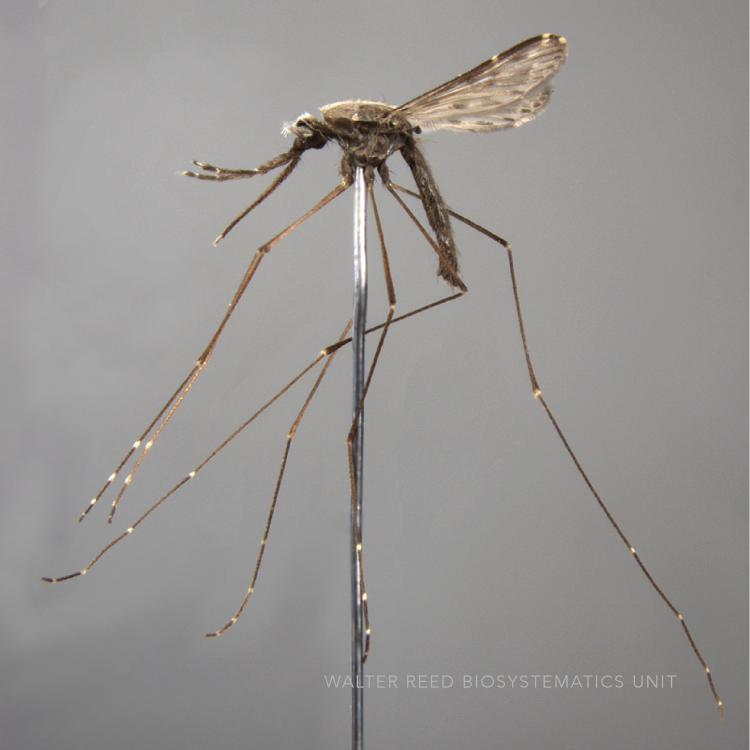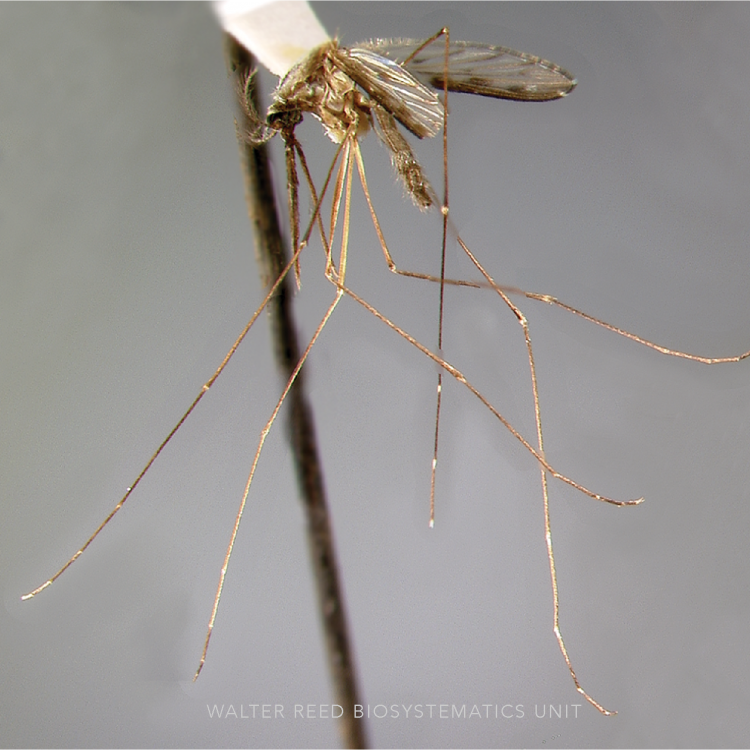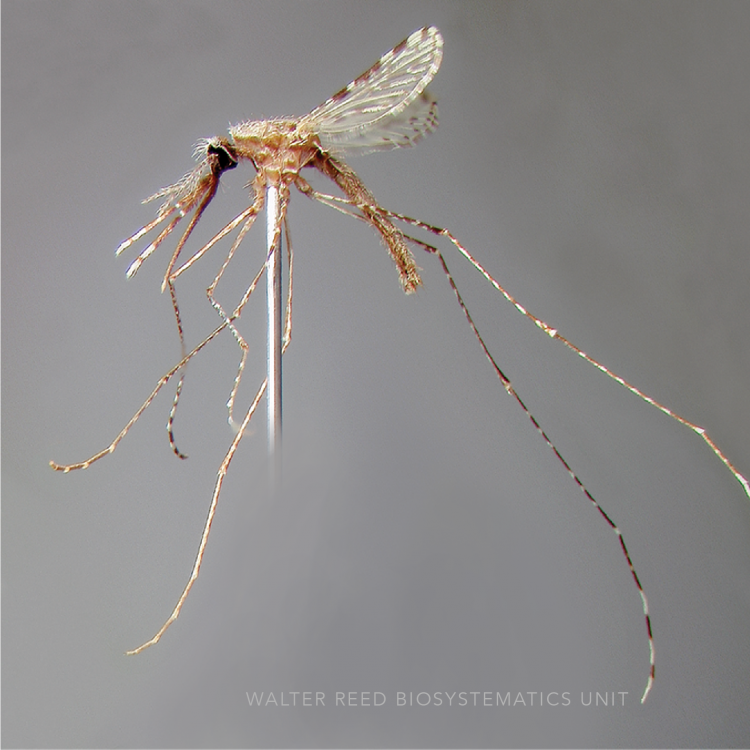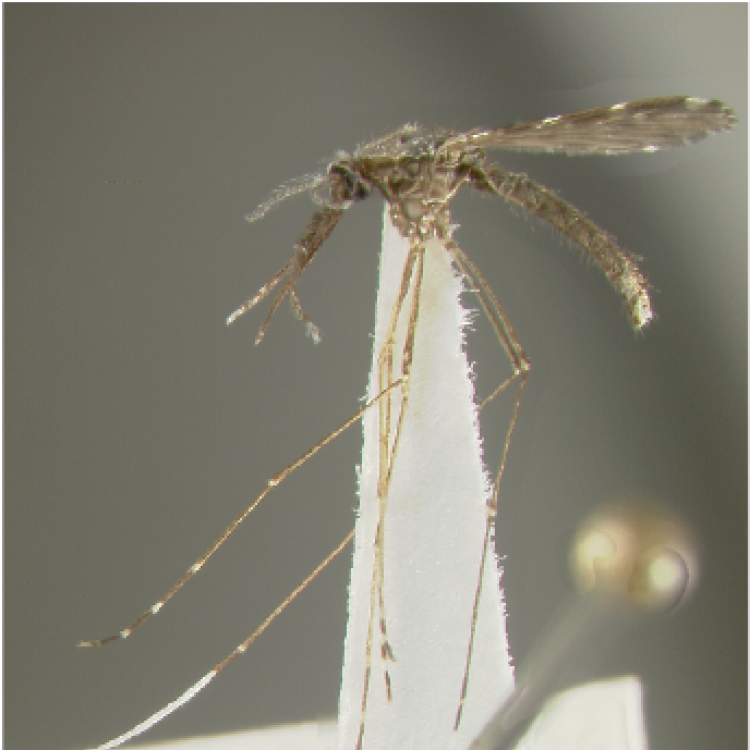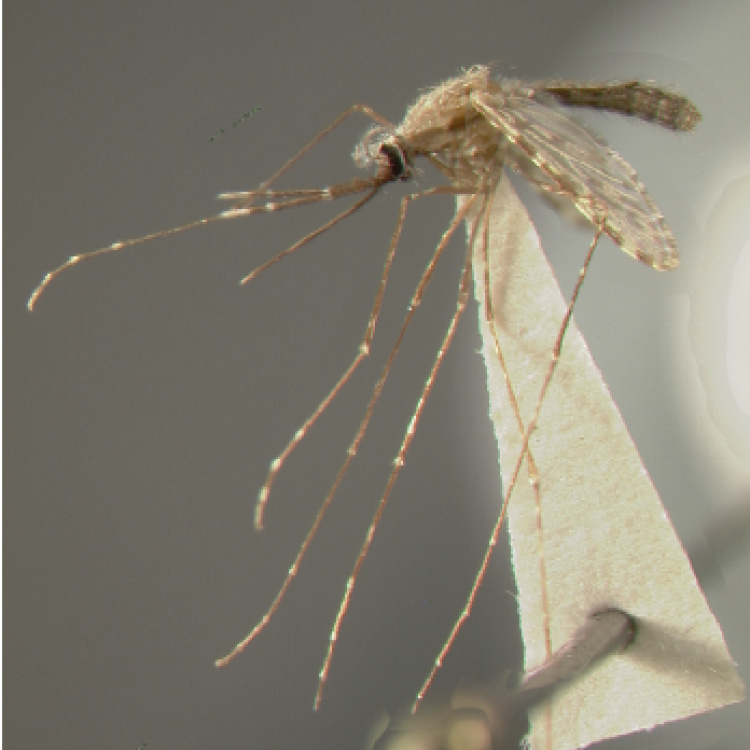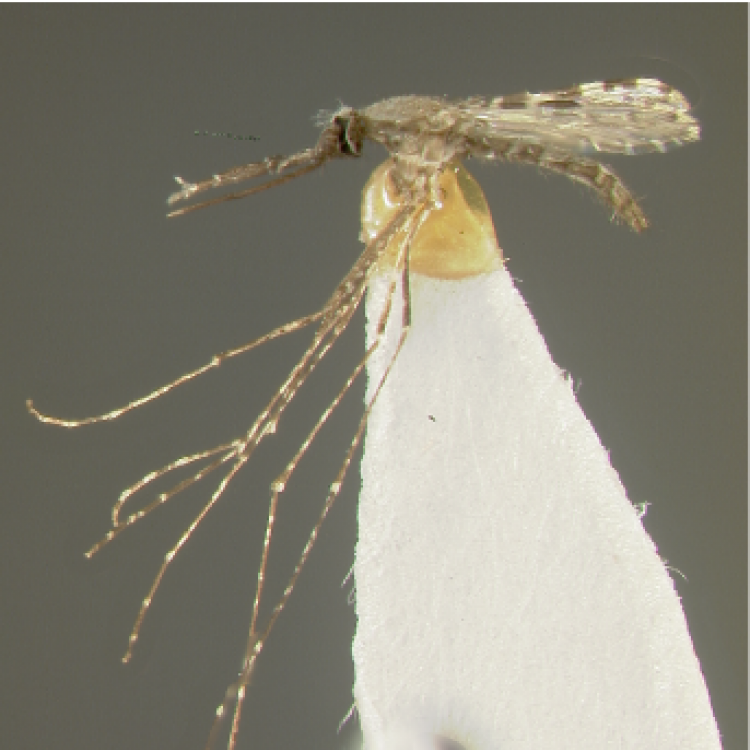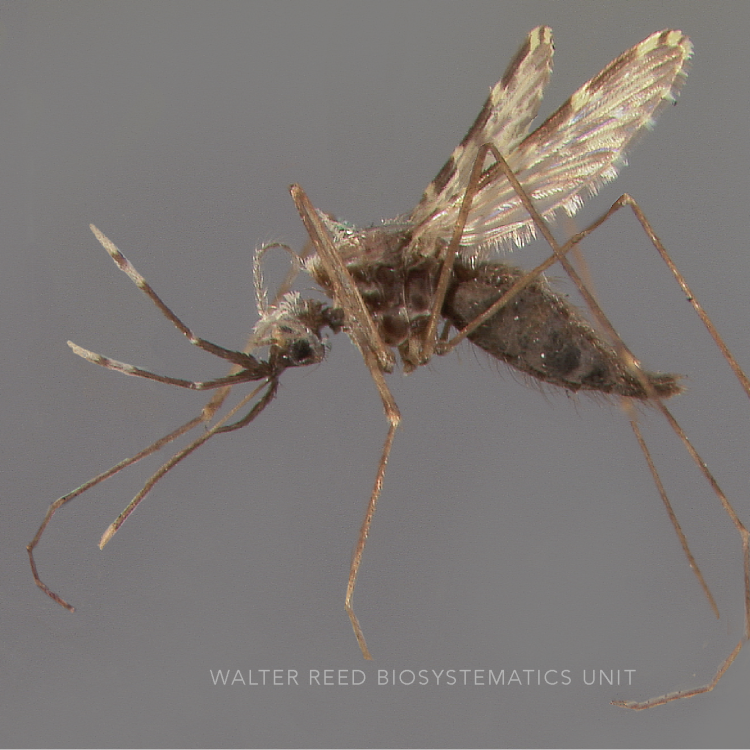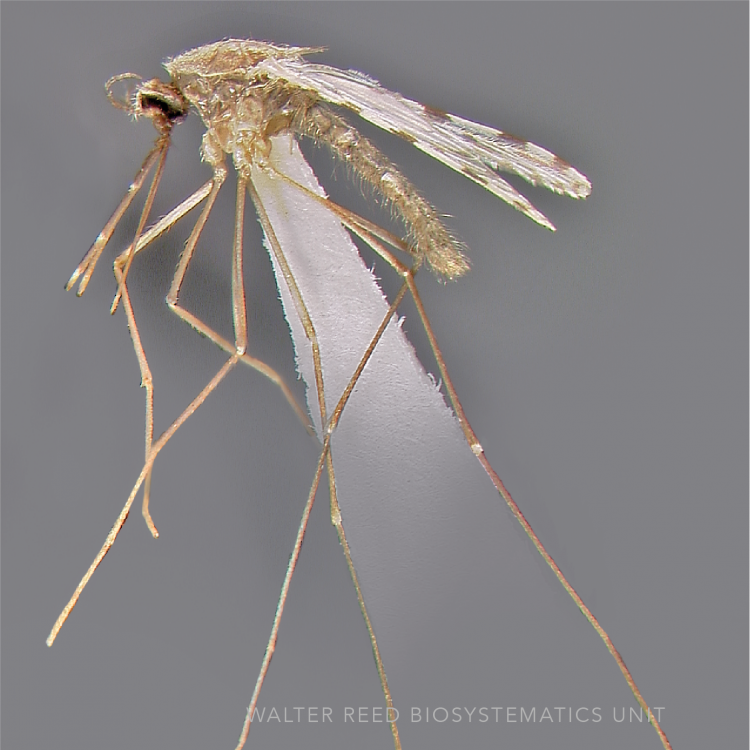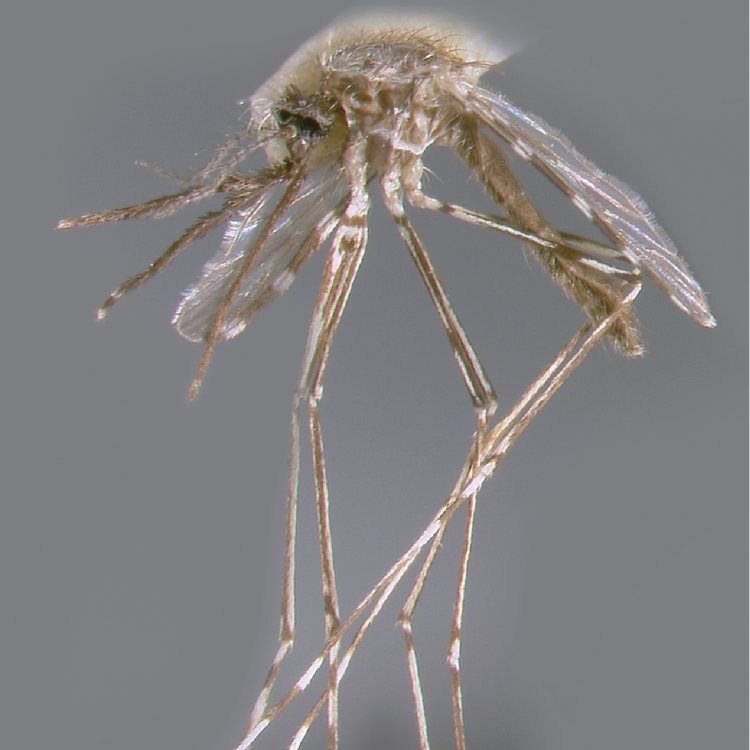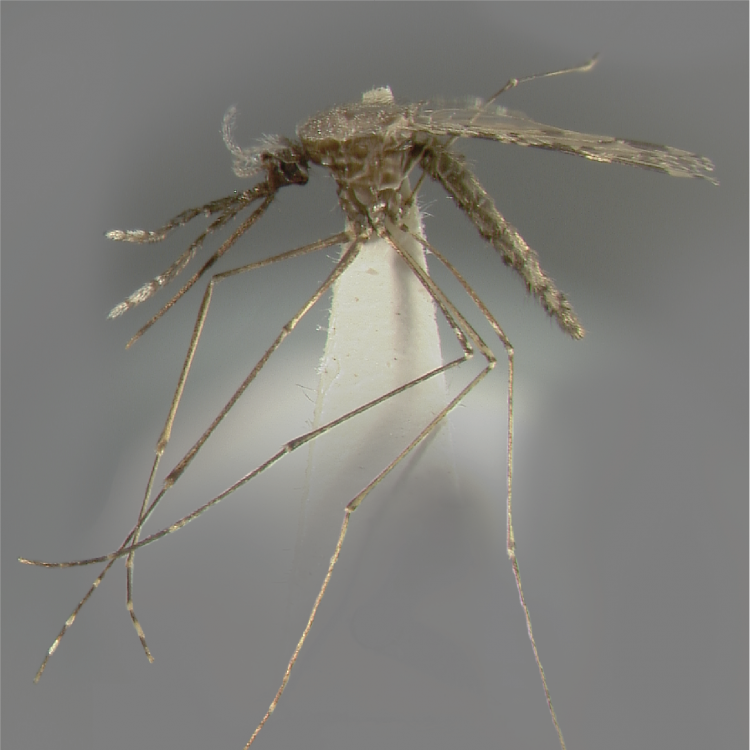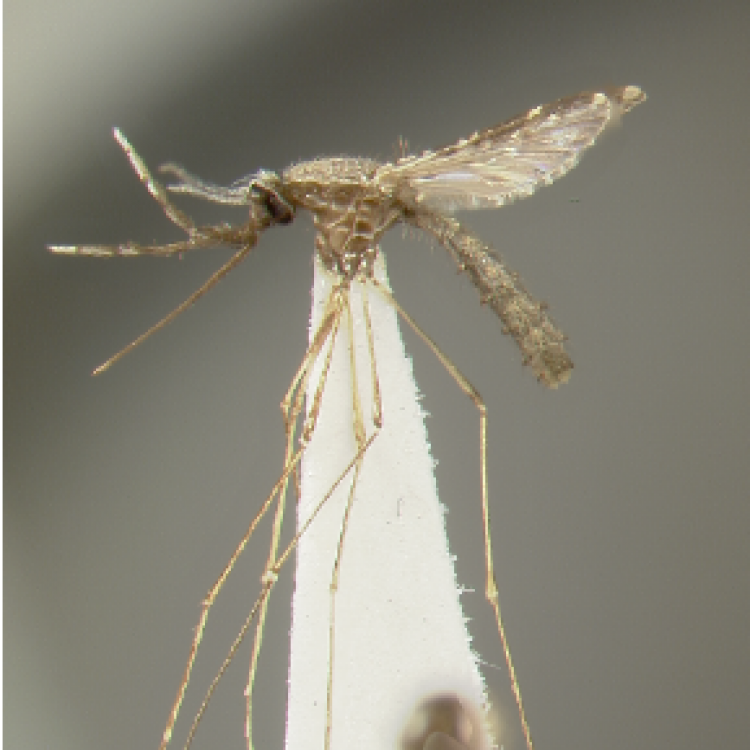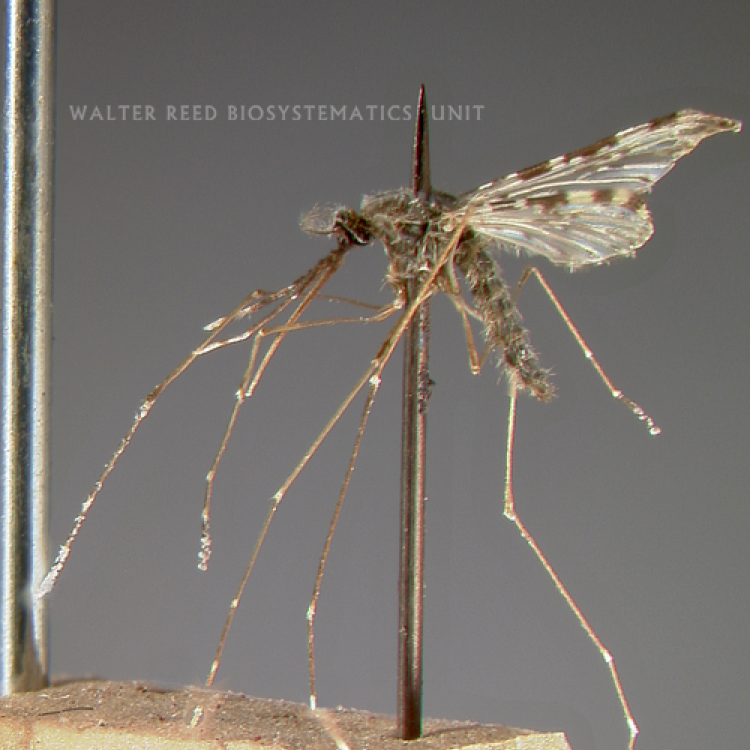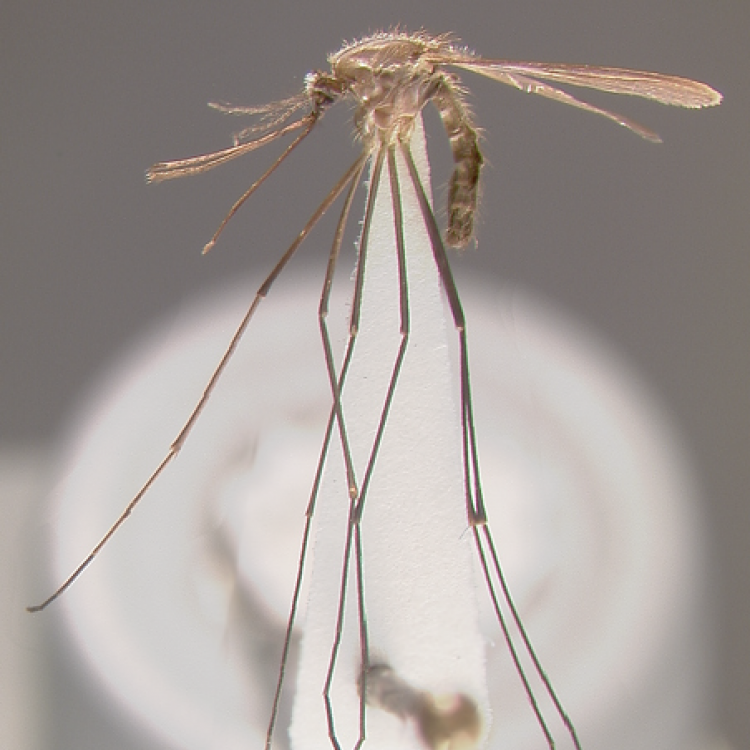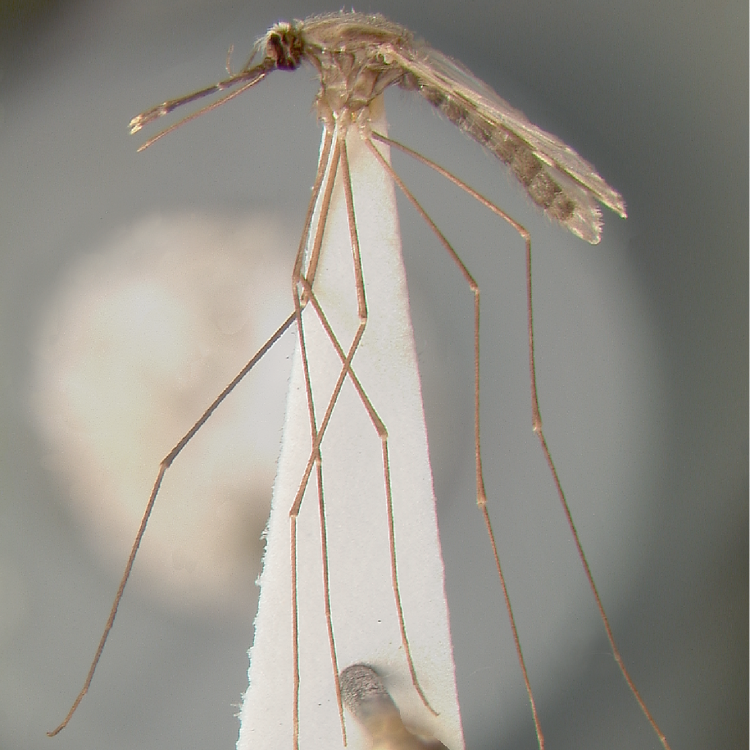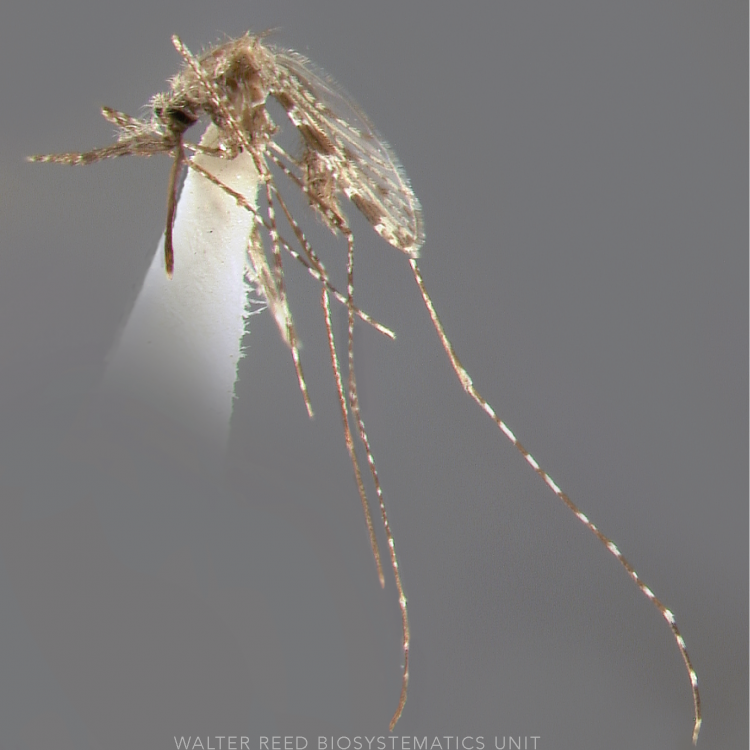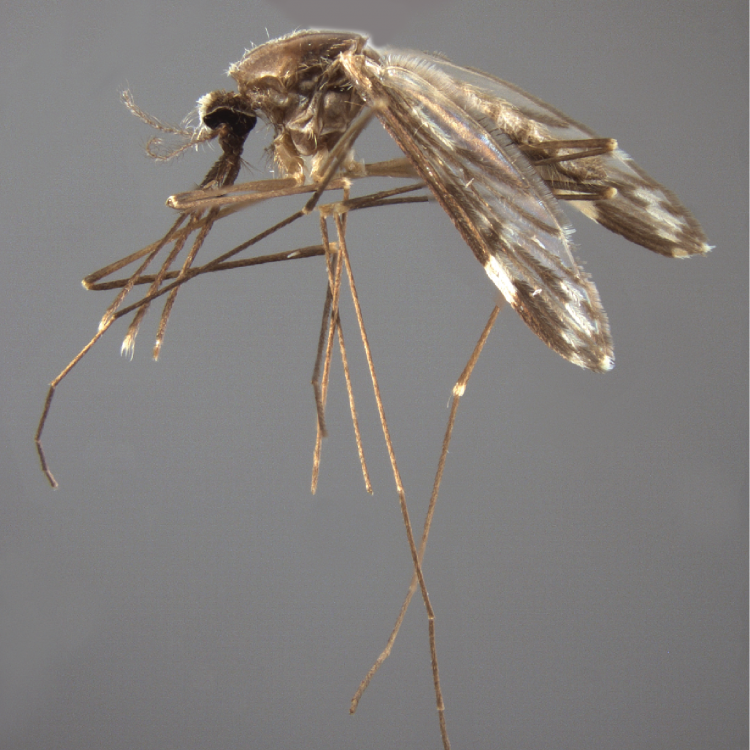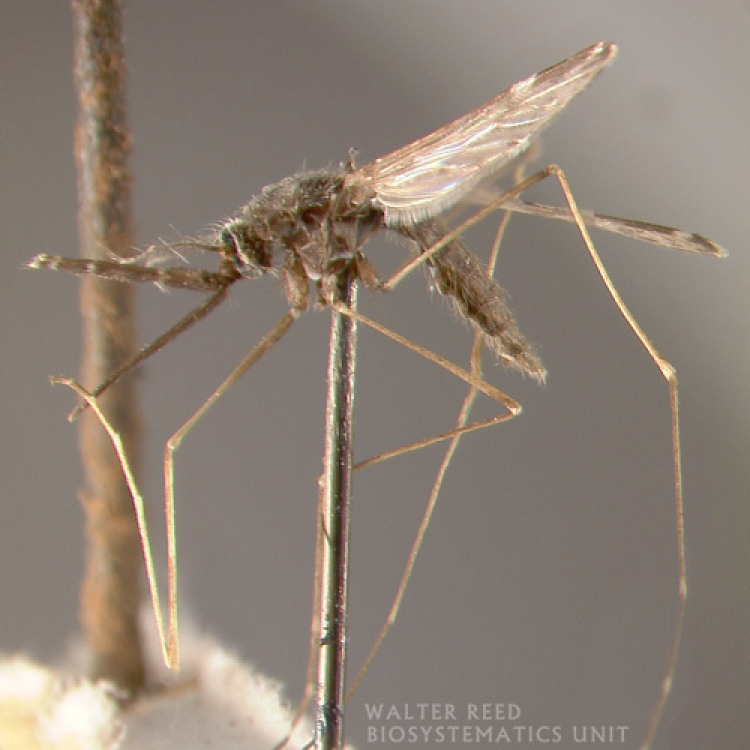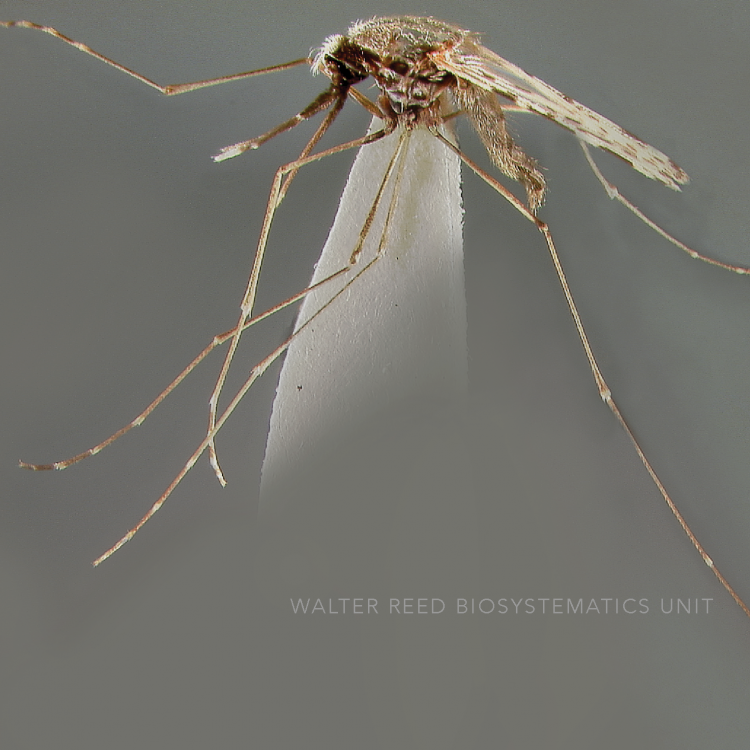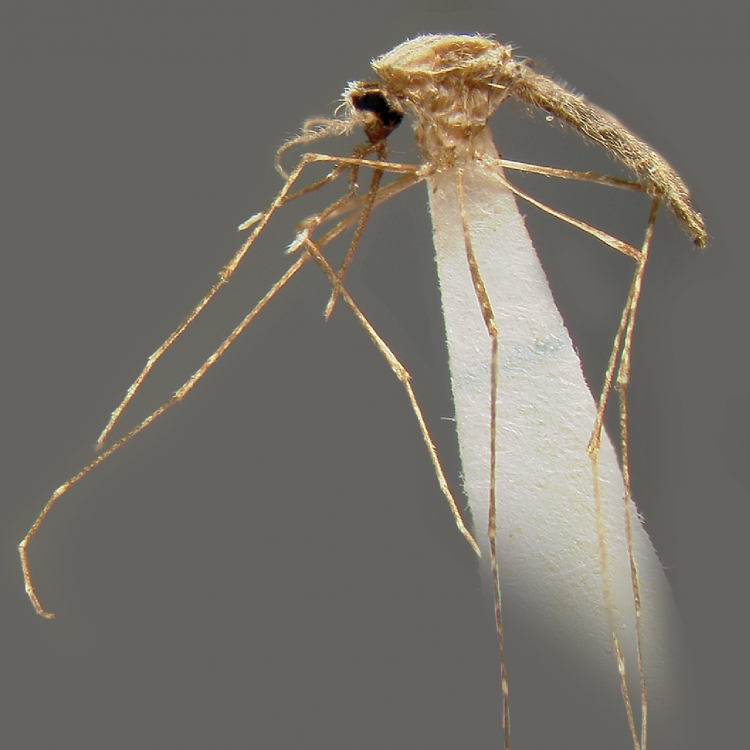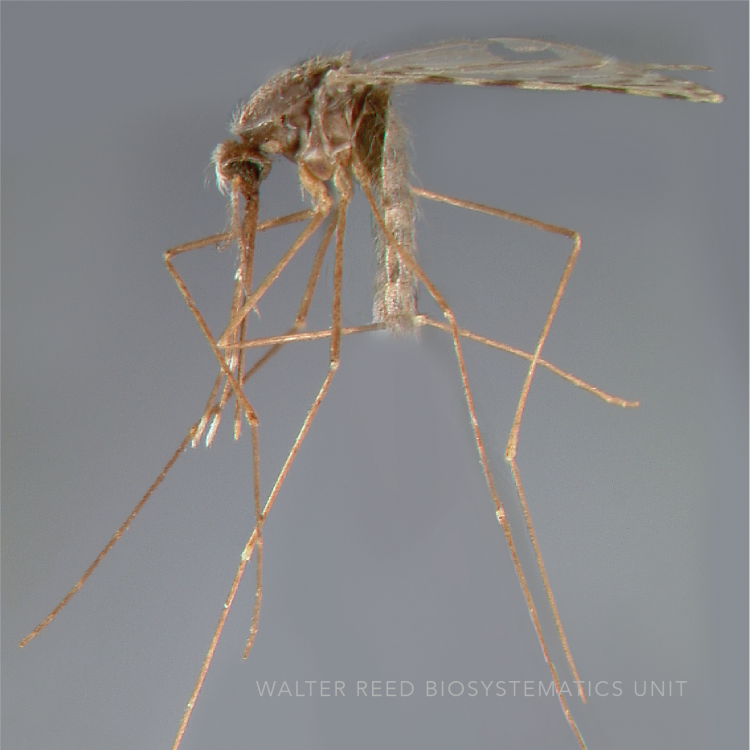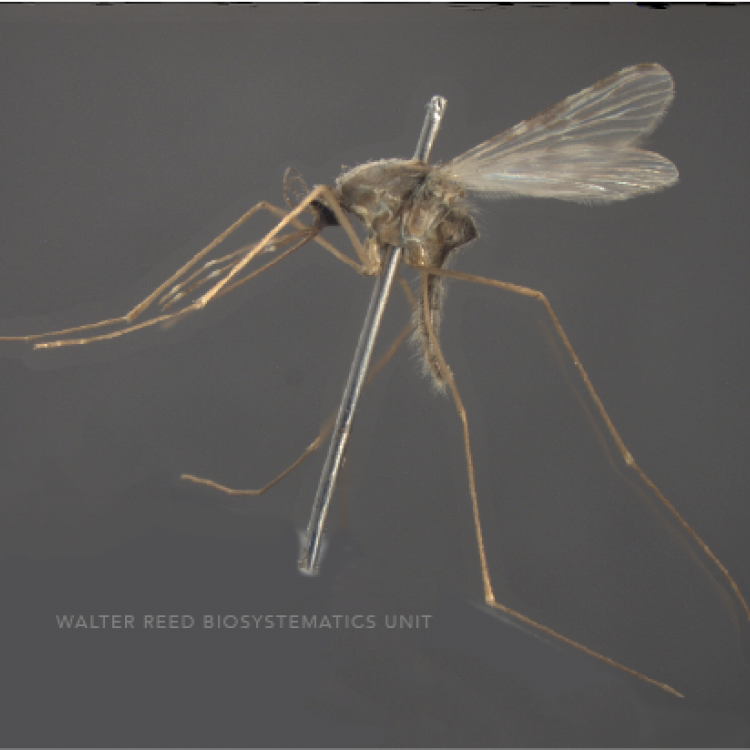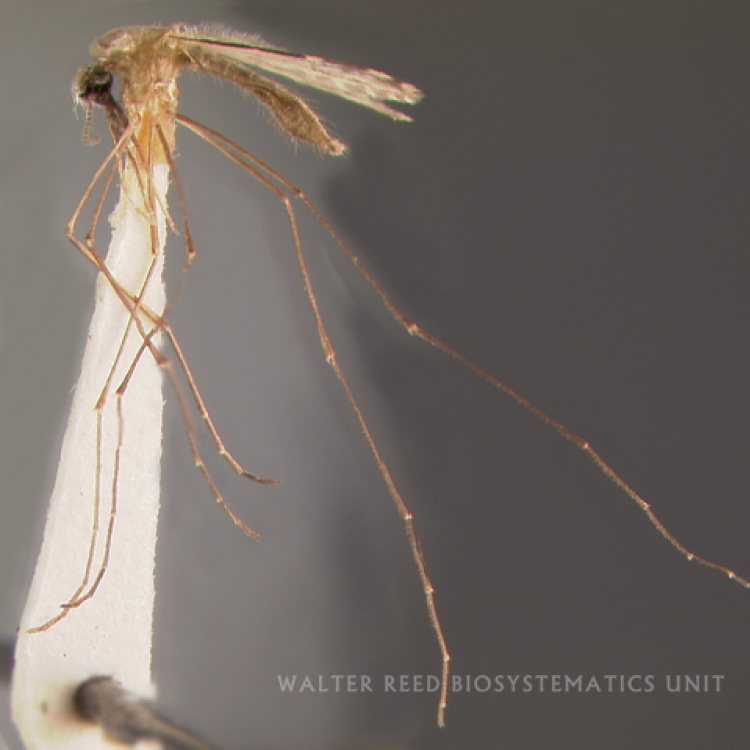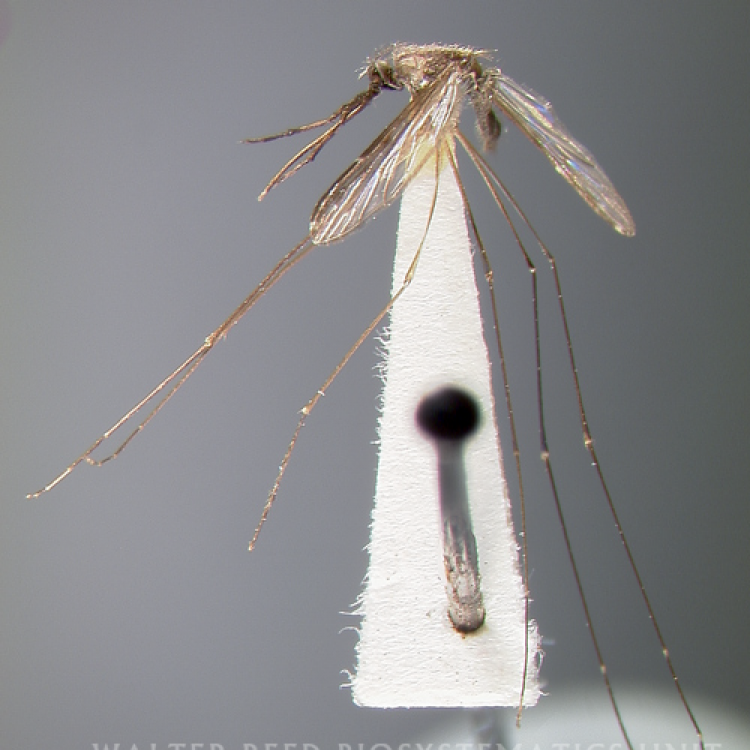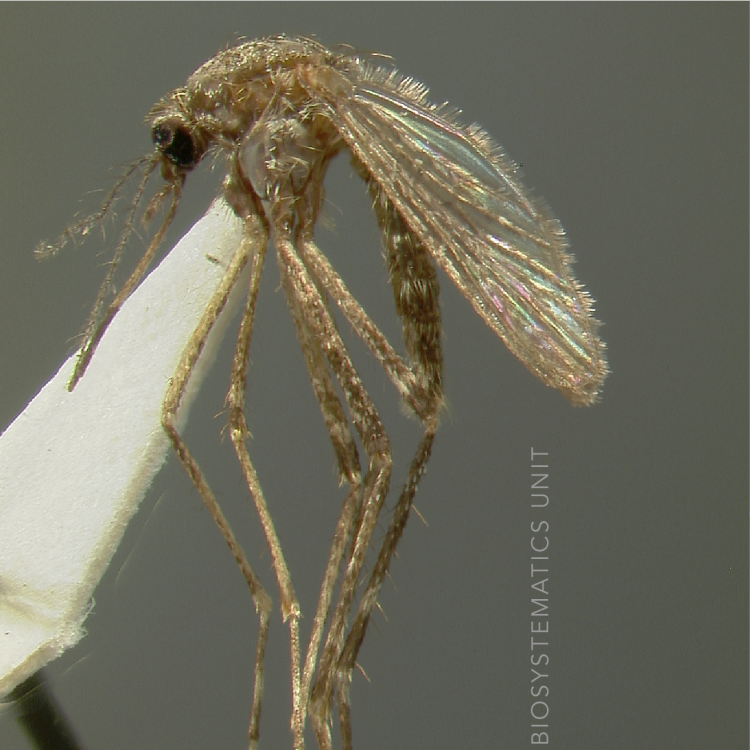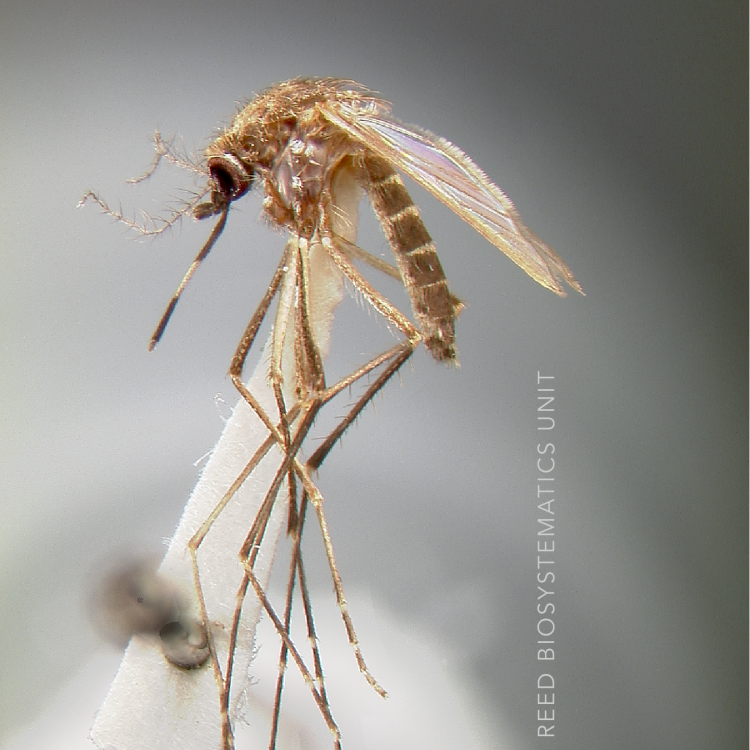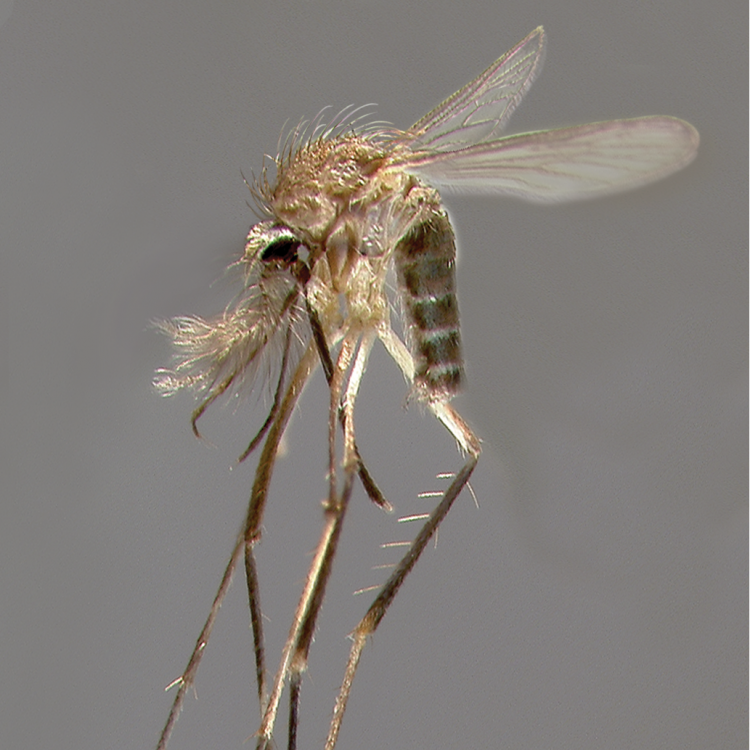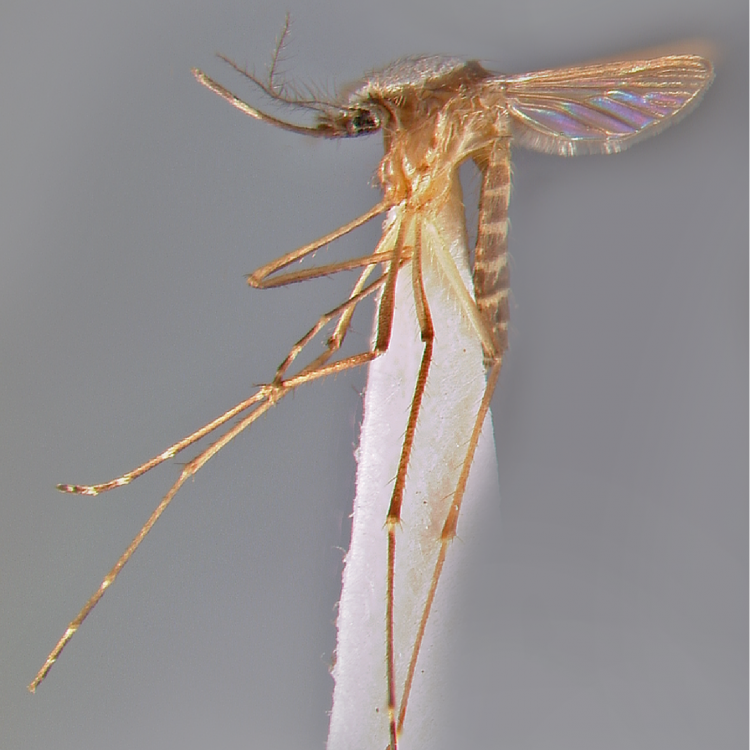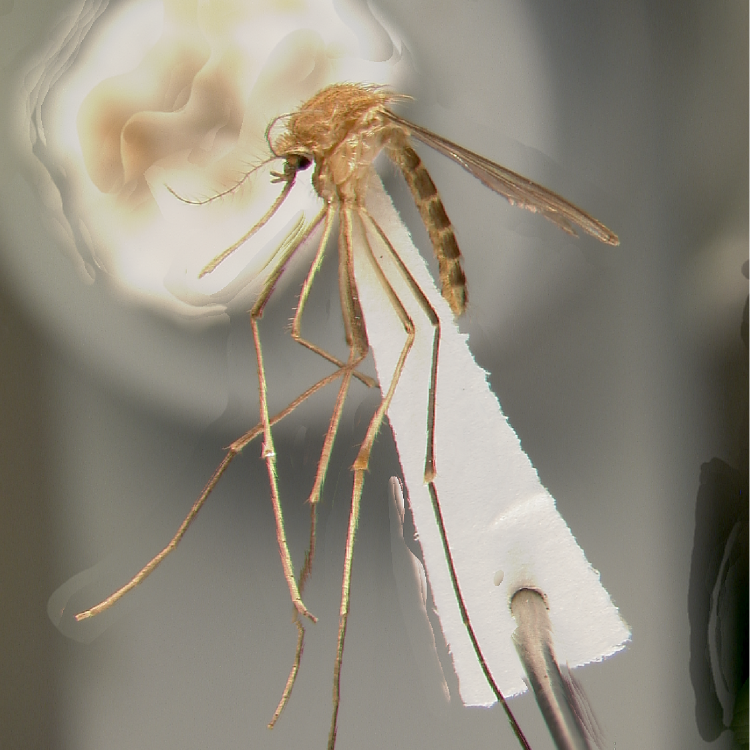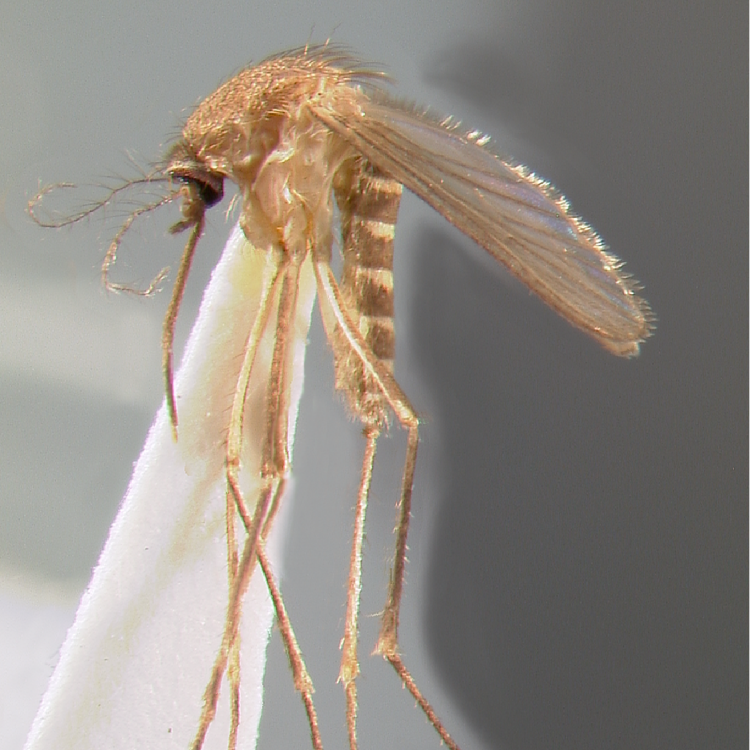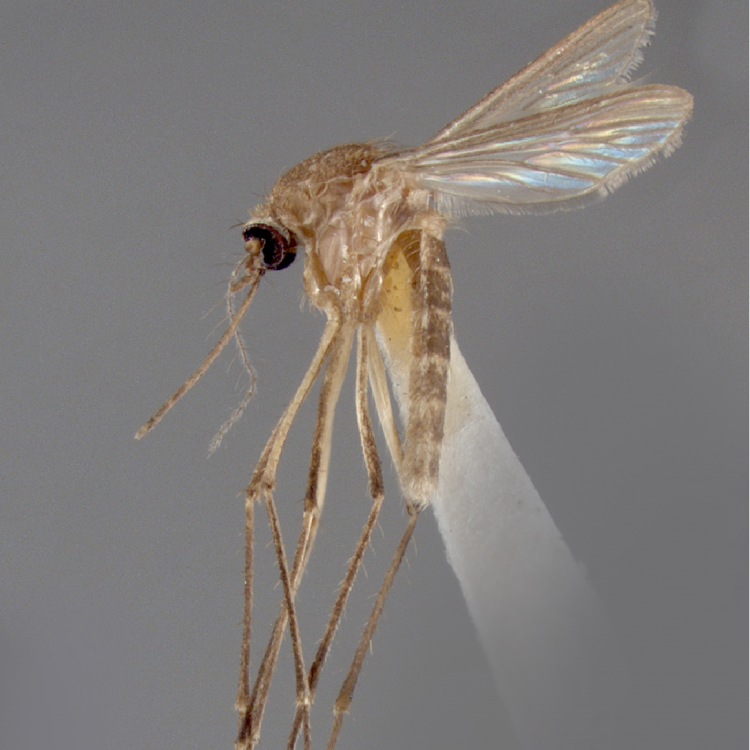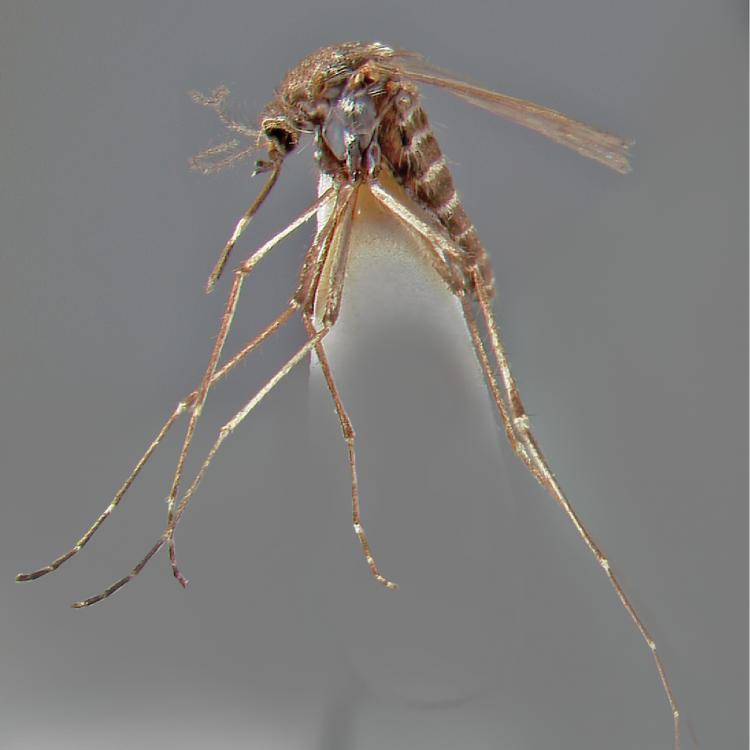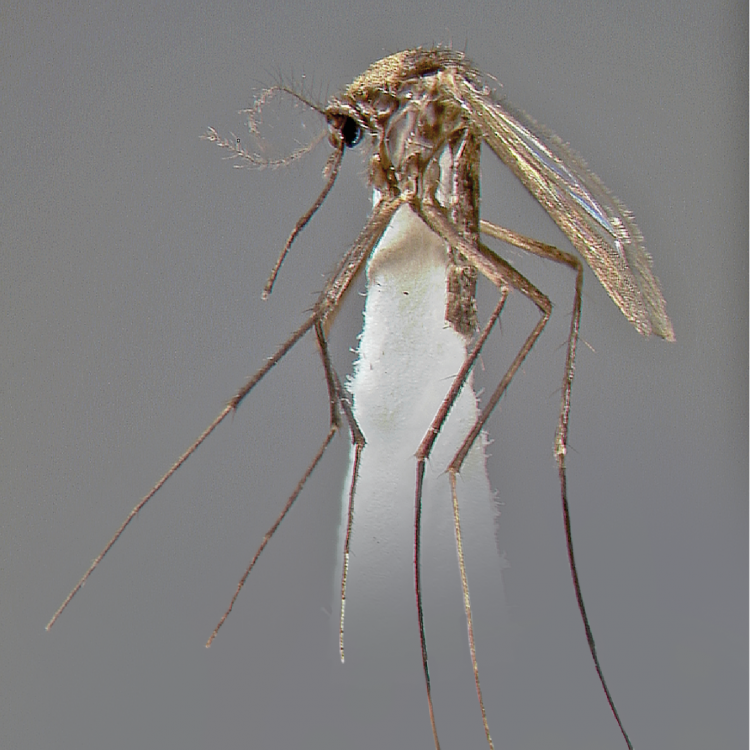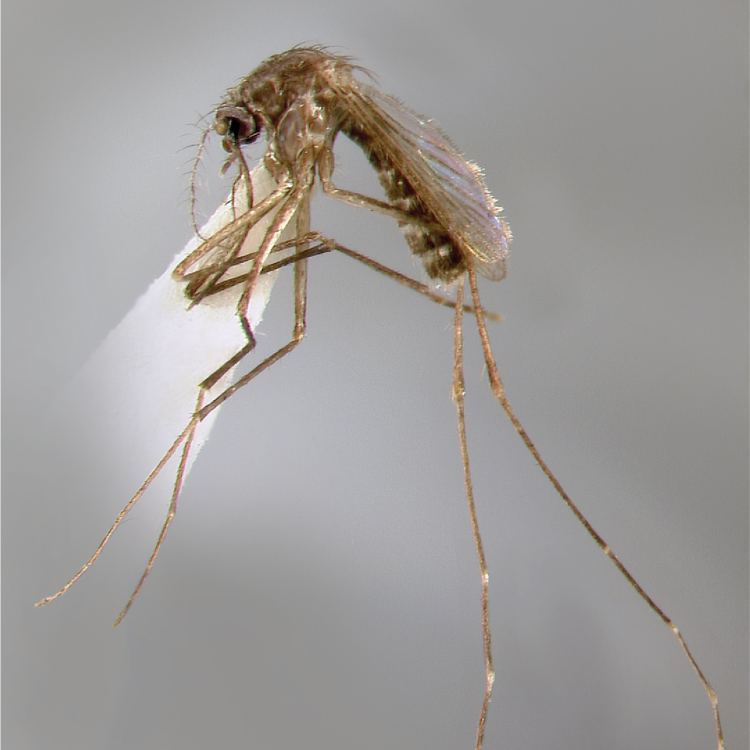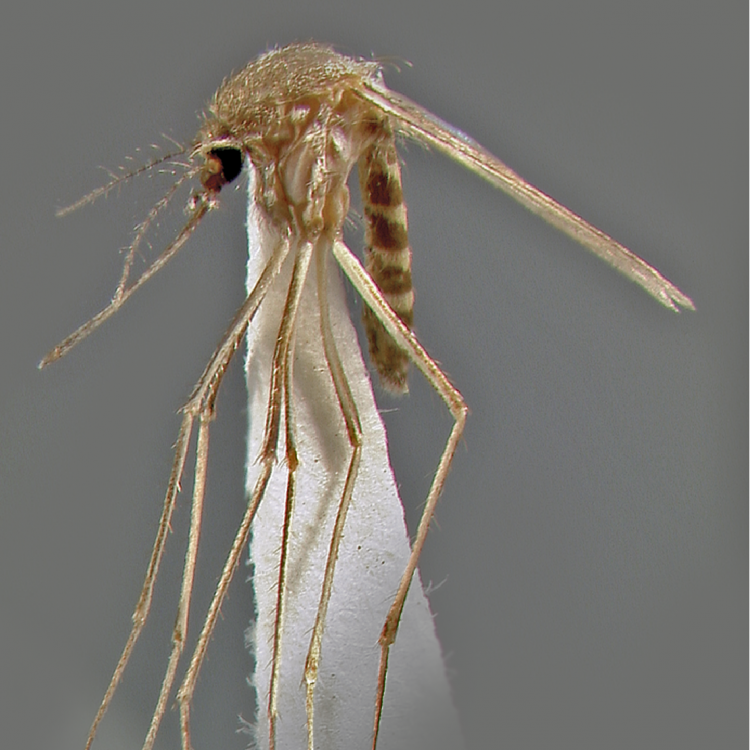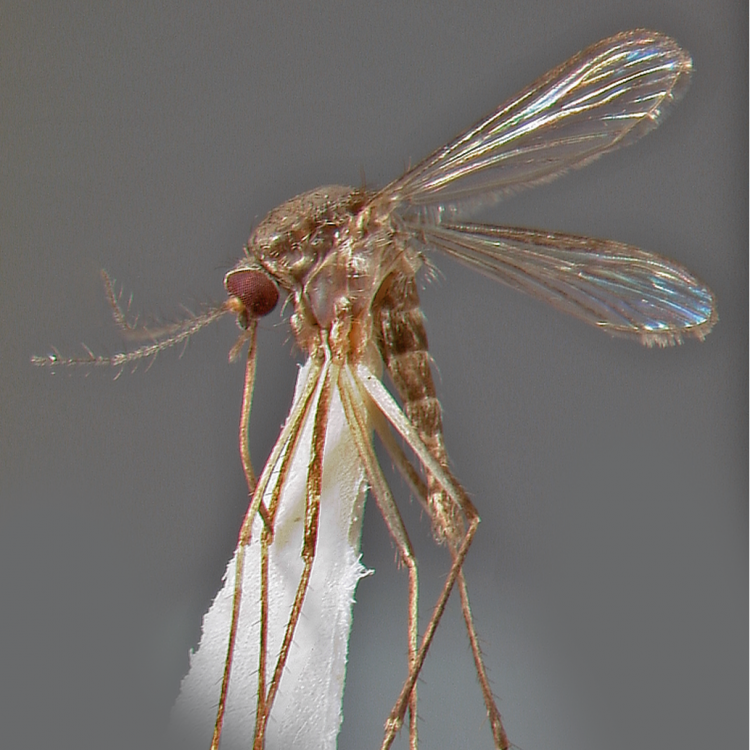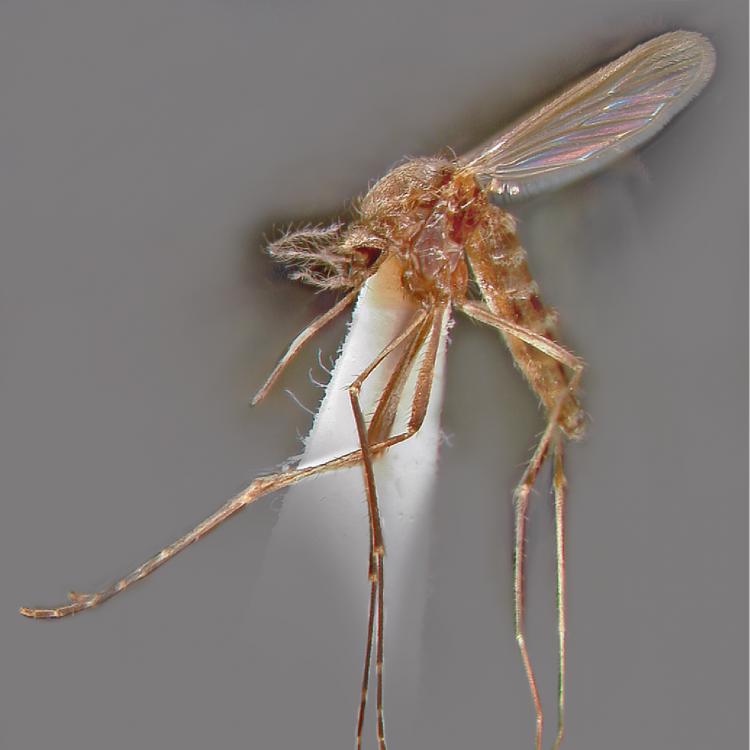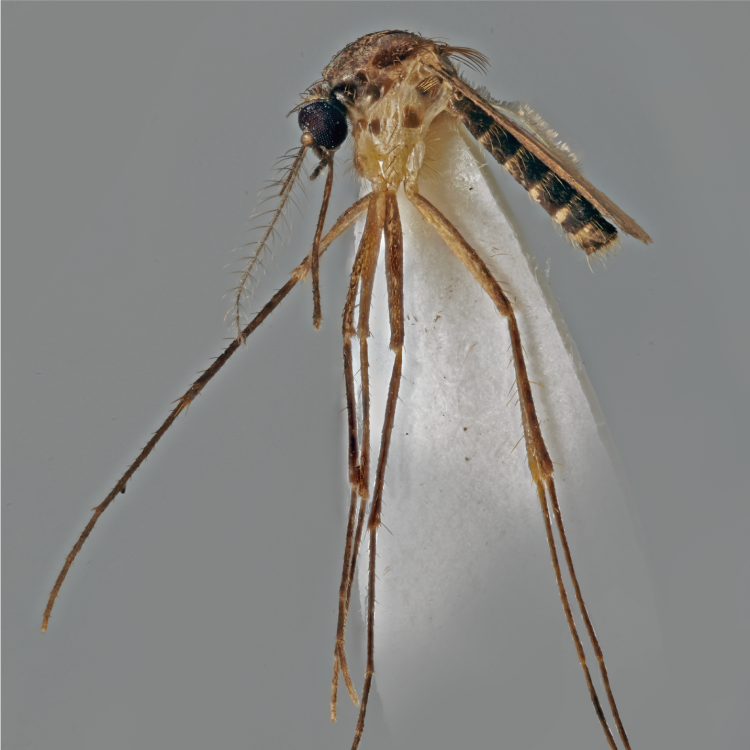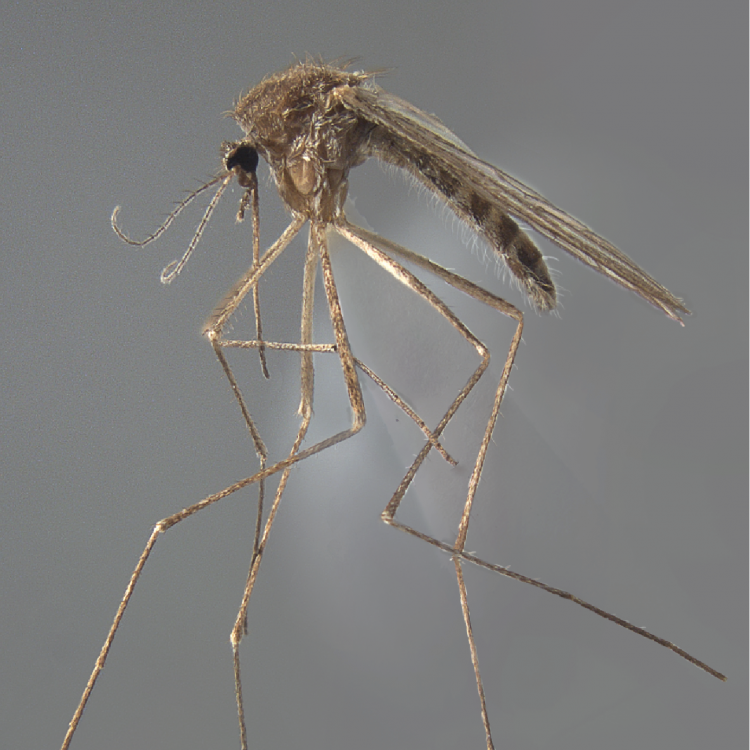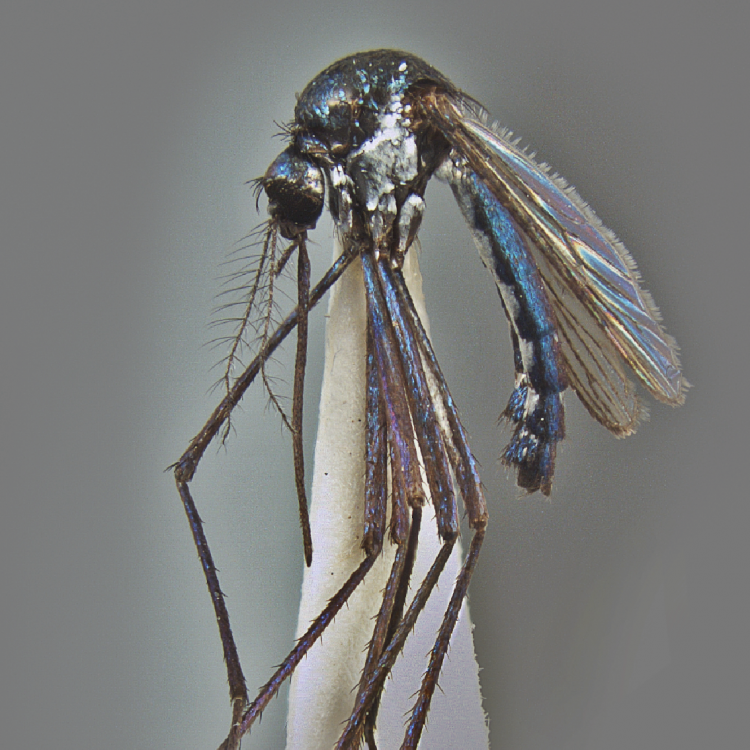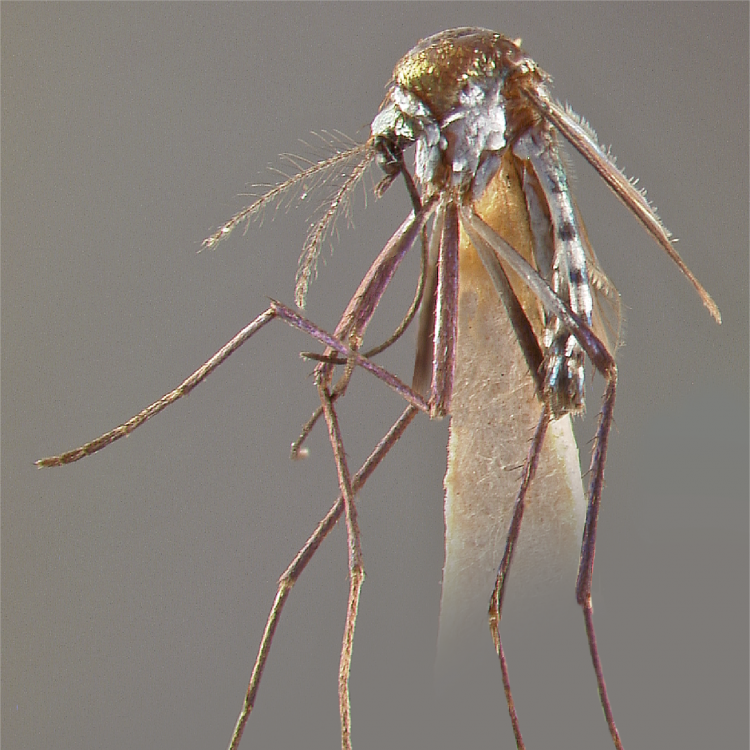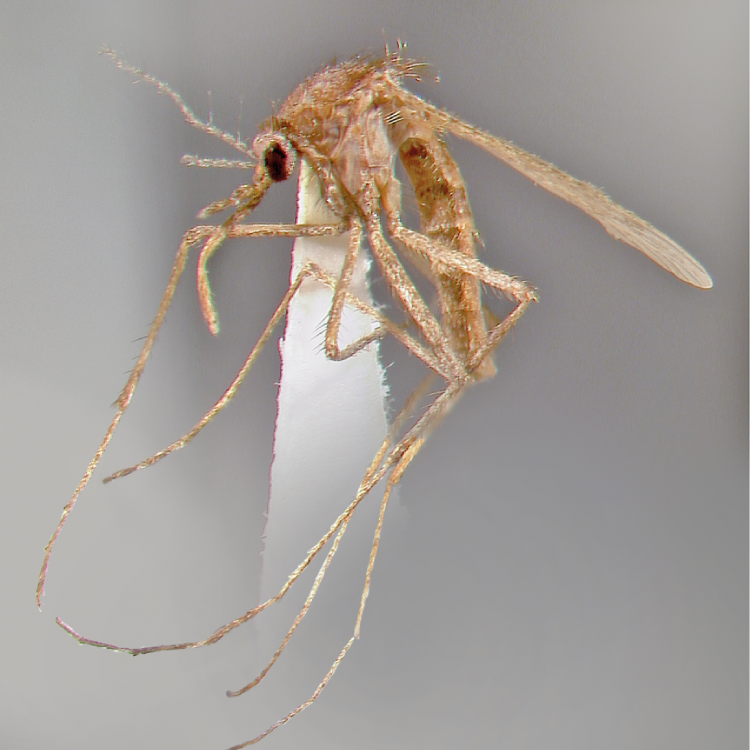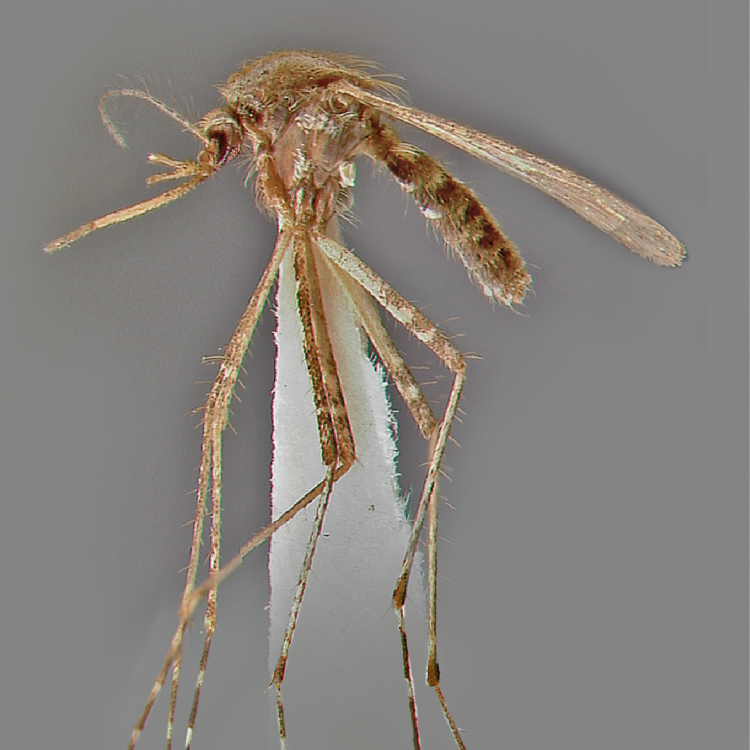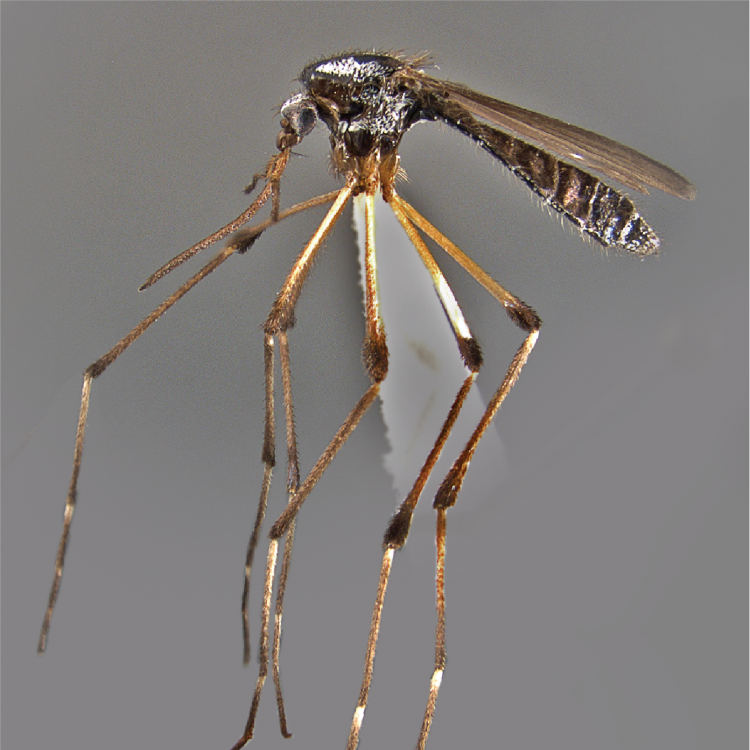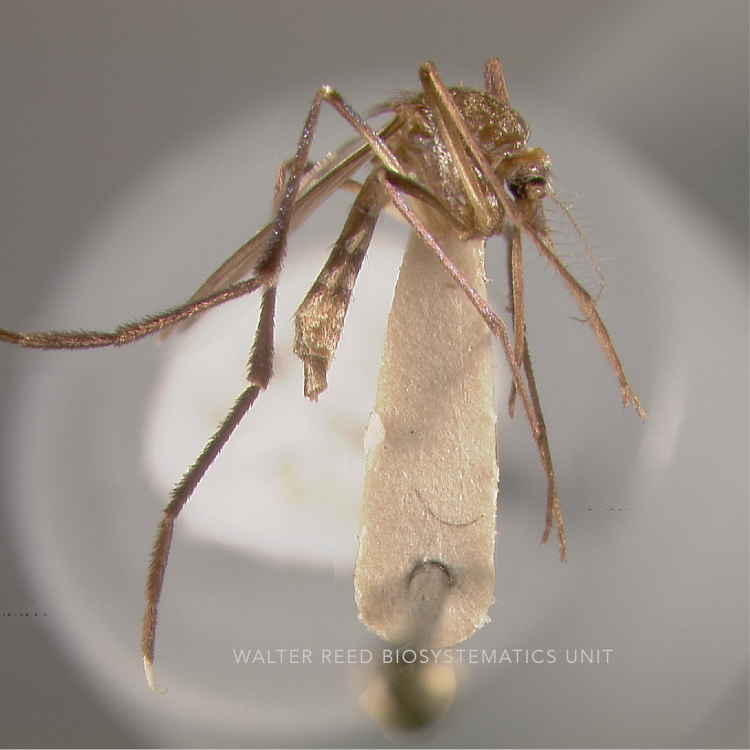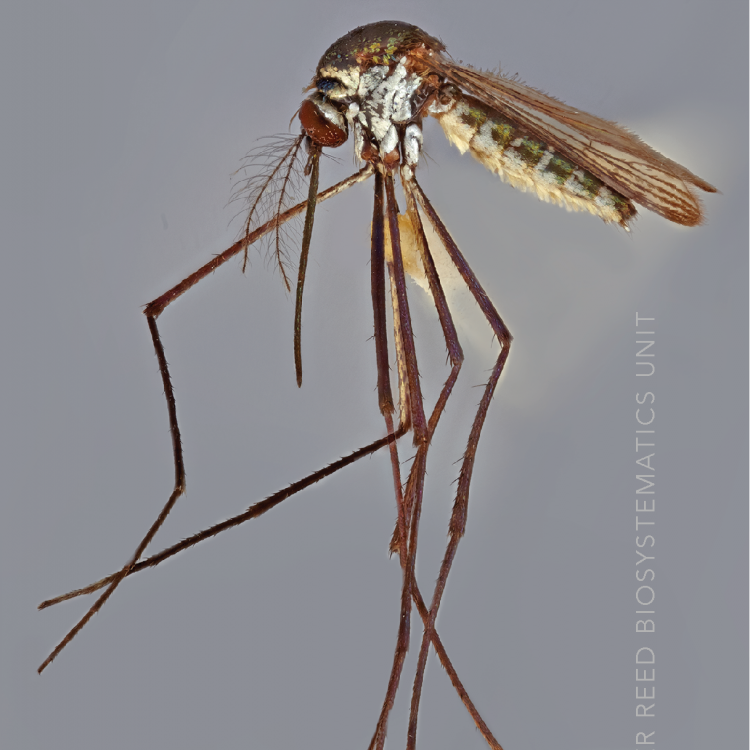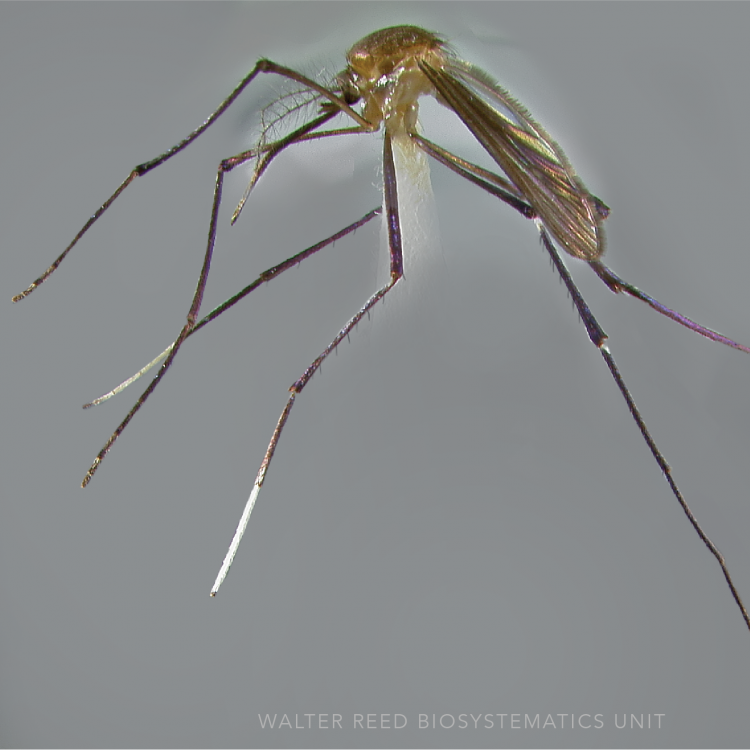PALEARCTIC REGION
Etymology: knee, jointed (L); ref. to white tibio-femoral joint
Aedes geniculatus are associated with deciduous forests across Europe, the Caucasus, and North Africa. They are strikingly ornamented, with golden-yellow, jet-black and white markings. Aedes geniculatus is closely related to two other Palearctic species: Ae. echinus (Edwards) and Ae. gilcolcolladoi (Sánchez-Covisa, Rodríguez Rodríguez & Guillén Llera).
Type locality: Paris, France
Type depository: Type non-existent (NE)
DIAGNOSTIC CHARACTERS (Click photos to view; mouse over and click large photo to zoom in.)
ADULT (illustrated): Head: Proboscis and palpus black-scaled. Proboscis distinctly longer than Fe-I; Ti-I–III and Ta-I–III all dark; Fe-I–III with apical pale spots. Thorax: Scutum with distinctive white and blackish pattern dominated by two dorsocentral blackish stripes; scutellar scales narrow, yellowish. Pleuron with patches of broad, whiteish scales. Abdomen: Distinct lateral triangular white patches dorsally; dark scales with purplish sheen. Genitalia (♀): Female cercus short, blunt.
LARVA (not illustrated): Head: Antenna without spicules, 0.5x length of head; seta 1-A single. Abdominal segments: Numerous stellate setae on thorax and abdomen; branches of stellate setae c. same length as segment. Terminal segments: Elongate comb scales in a single row of 8–15; comb scales with strong apical spinules and small lateral spinules; pecten with 15–19 long spines; seta 1-S 4,5 branched; seta 4-X with 7–10 setae on grid and 1–2 precratal setae; siphon index 2.3–3.2; acus present on base of siphon.
TAXONOMIC KEYS
Becker et al. 2010
Exemplar DNA sequences
Ae. geniculatus COI: KM457576–78, KP942765–68, KP942753–55, MH392201–05
BIONOMICS
Immatures
Female Ae. geniculatus lays batches of c. 70 eggs in the mid-afternoon. It prefers to oviposit in tree holes up to 4m high in broadleaf trees, like birch, alder, and non-native maple, but is also found in oak. Larvae have occasionally been recovered from small ground pools. Few eggs hatch in the same year as they are laid; with most eggs surviving the winter to hatch the following spring.
Adults
When abundant, as in southeastern Europe, the day-biting females can be a significant biting nuisance. In England, adult emergence occurs from May to September, with highest biting densities, and seasonal oviposition peaks in the warmest months of July and August. Populations in its northerly distribution overwinter as eggs, and appears to be univoltine. In warmer climates, Ae. geniculatus will overwinter both as eggs and as larvae.
DISTRIBUTION NOTES
Albania, Armenia, Austria, Azerbaijan, Belarus, Belgium, Bulgaria, Crimean Peninsula, Corsica, Croatia, Czech Republic, Denmark, Finland, France (includes Corsica), FYRO Macedonia, Republic of Georgia, Germany, Greece, Hungary, Iran, Italy (includes Sardinia & Sicily), Kaliningrad Oblast, Kazakhstan, Lebanon, Lithuania, Luxembourg, Moldova, Montenegro, Morocco, Netherlands, Norway, Poland, Portugal, Romania, Russia (central, northwestern, Southern & Volga Districts), Serbia, Slovakia, Slovenia, Spain, Sweden, Switzerland, Turkey, Turkmenistan, Ukraine, United Kingdom.

WRBU VECTOR HAZARD REPORTS
None; View other WRBU Vector Hazard Reports
Available GIS Models:
None
IMPORTANT REFERENCES (full citations below)
Brolemann 1919b (F*)
Edwards 1921d: 319 (F*, L*)
Séguy 1924: Pl.XXI (L*), 71 (M genitalia*), 83 (F*)
MacGregor 1932: 183 (E; bionomics)
Marshall 1938: 150 (M*, F*, L*, E*)
Clavero 1946: 20 (M*, P*, L*)
Natvig 1948: 389 (M*, F, L*; taxonomy, bionomics)
Mohrig 1967 (F*)
Sicart & Larrouy 1968 (F*)
Mohrig 1969 (F*)
Rjazantzeva 1970 (F*)
Gutsevich et al. 1974: 295 (M*, F*, L*)
Skierska 1977 (F*)
Mgeladze 1991: 329 (distribution; Georgia)
Alten et al. 2000 (distribution; Turkey)
Eritja et al. 2000: 11 (distribution; Spain)
Dahl & Blackmore 2001: 14 (distribution; Denmark, Norway & Sweden)
Ribeiro et al. 2002 (distribution; Portugal)
Reinert 2002e: Fig. 3 (F*)
Beck et al. 2003: 24 (distribution; Luxembourg)
Trari et al. 2002: 331 (distribution; Morocco)
Reinert 2008c: Fig. 1 (F*)
Becker et al. 2010: 206 (M*, F*, L*; keys, taxonomy., distribution, bionomics)
Namazov 2014 (distribution.; Azerbaijan)
Robert et al. 2019 (distribution, Euro-Mediterranean)
CURRENT SYNONYMS
syn. guttatus Meigen
1818: 5 (A; Culex). Type locality: Europe (type non existent).
syn. lateralis Meigen
1818: 5 (A; Culex). Type locality: Austria (type non existent).
syn. ornatus Meigen
1818: 5 (A; Culex). Type locality: Europe (type non existent).
syn. guttatus Curtis
1835: 537 (M*, F*; Culex). Type locality: Cobham, Surrey, England (NMM).
syn. albo-punctatus Rondani
1872: 31 (M; Culex). Type locality: Italy (type location unknown).
CITED REFERENCES
Alten, B., Caglar, S.S., & Ozer, N. (2000). Malaria and its vectors in Turkey. European Mosquito Bulletin, 7, 27–33.
Beck, M., Galm, M., Weitzel, T., Fohlmeister, V., Kasiser, A., Arnold, A., & Becker, N. (2003). Preliminary studies on the mosquito fauna of Luxembourg. European Mosquito Bulletin, 14, 21–24.
Becker, N., Petrić, D., Zgomba, M., Boase, C., Madon, M., Dahl, C., & Kaiser, A. (2010). Mosquitoes and their control (Second ed.). Berlin Heidelberg: Springer-Verlag.
Brolemann, H.W. (1919b). Sur quelques Culex des Pyrenées. II. Campagne 1918. Annales de la Société Entomologique de France, 88, 65–103.
Clavero, G. (1946). Aedinos de España. Revista de Sanidad e Higiene Pública, 20, 1–28.
Dahl, C., & Blackmore, M.S. (2001). The distribution and status of Ochlerotatus geniculatus (Olivier) in Fennoscandia. European Mosquito Bulletin, 9, 12–16.
Edwards, F.W. (1921d). A revision of the mosquitos [sic] of the Palaearctic Region. Bulletin of Entomological Research, 12, 263–351.
Eritja, R., Aranda, C., Padrós, J., Goula, M., Lucientes, J., Escosa, R., . . . Cáceres, F. (2000). An annotated checklist and bibliography of the mosquitoes of Spain (Diptera: Culicidae). European Mosquito Bulletin, 8, 10–18.
Gutsevich, A.V., Monchadskii, A.S., & Shtakel’berg, A.A. (1974). Fauna of the USSR. New series No. 100 Diptera. Vol. III, No. 4. Mosquitoes. Family Culicidae. Jerusalem, Israel: Keter Publishing House Jerusalem Ltd. (Original work published 1971).
MacGregor, M.E. (1932). The ova of Aedes (Finlaya) geniculatus Olivier. Parasitology, 24, 183–184.
Maciá, A., & Bradshaw, W.E. (2000). Seasonal availability of resources and habitat degradation for the western tree-hole mosquito, Aedes sierrensis. Oecologia, 125(1), 55–65.
Marshall, J.F. (1938). The British Mosquitoes. London: The British Museum (Natural History).
Mgeladze, V. (1991). Species composition of mosquito Aedes (Diptera, Culicidae) in Georgia. Soobshcheniya Akademii Nauk Gruzii, 143(3), 329–331.
Mohrig, W. (1967). Die taxonomische Bedeutung der Struktur weiblicher Genitalien im Culiciden- Tribus Aedini. Angewandte Parasitologie, 8, 67–100.
Mohrig, W. (1969). Die Culiciden Deutschlands. Untersuchungen zur Taxonomie, Biologie und Okologie der einheimischen Stechmucken. Parasitologische Schriftenreihe, 1–260.
Namazov, N. D. (2014). The distribution of mosquitoes (Diptera: Culicidae) in the Republic of Azerbaijan. Entomological Review, 92, 280–282.
Natvig, L.R. (1948). Contributions to the knowledge of the Danish and Fennoscandian mosquitoes: Culicini. Norsk Entomologisk Tidsskrift Suppl., 1, xxiii + 567 pp., 512 pls, 561 map.
Reinert, J.F. (2002e). Comparative anatomy of the female genitalia of genera and subgenera in tribe aedini (Diptera: Culicidae). Part XIII. Genus Ochlerotatus Lynch Arribalzaga. Contributions of the American Entomological Institute, 33(1), 1–111.
Reinert, J.F. (2008c). Comparative anatomy of the female genitalia of generic-level taxa in tribe Aedini (Diptera: Culicidae). Part XVII. Genus Dahliana Reinert, Harbach and Kitching. Contributions of the American Entomological Institute, 35(2), 21–29.
Ribeiro, H., & Alves-Pires, C. (2002). Research on the mosquitoes of Portugal (Diptera, Culicidae). 12 The mosquitoes of Minho and Douro Litoral. Serie de Zoologia.
Rjazantzeva, A. E. (1970). The structure of female genitalia of bloodsucking mosquitoes of the genus Aedes (Diptera, Culicidae). Parassitologia, 4, 401–407.
Robert, V., Günay, F., Le Goff, G., Boussès, P., Sulesco, T., Khalin, A., Medlock, J.M., Kampen, H., Petrić, D. & F. Schaffner. (2019). Distribution chart for Euro-Mediterranean mosquitoes (western Palaearctic region). Journal of the European Mosquito Control Association, 37, 1–28.
Séguy, E. (1924). Les moustiques de l'Afrique Mineure, de l'Egypte et de la Syrie. Encyclopedie Entomologique (A), 1, 1–257.
Sicart, M. & Larrouy, G. (1968) Culicid fauna of the Toulouse Region, female genitalia of the regional Aedes. Bulletin de la Société d’Histoire naturelle de Toulouse, 104, 104-109.
Skierska, B. (1977). [Culicidae.]. Klucze do Oznaczania Owadow Polski, 28(96), 1–119.
Trari, B., Dakki, M., Himmi, O., & El Agbani, M.A. (2002). Le moustiques (Diptera: Culicidae) du Maroc: Revue bibliographique (1916–2001) et inventaire des espèces. Bulletin de la Société de pathologie exotique (Paris), 96(4), 329–334.
CITE THIS PAGE
Walter Reed Biosystematics Unit (Year). Aedes geniculatus species page. Walter Reed Biosystematics Unit Website, http://wrbu.si.edu/vectorspecies/mosquitoes/geniculatus , accessed on [date (e.g. 03 February 2020) when you last viewed the site].


